






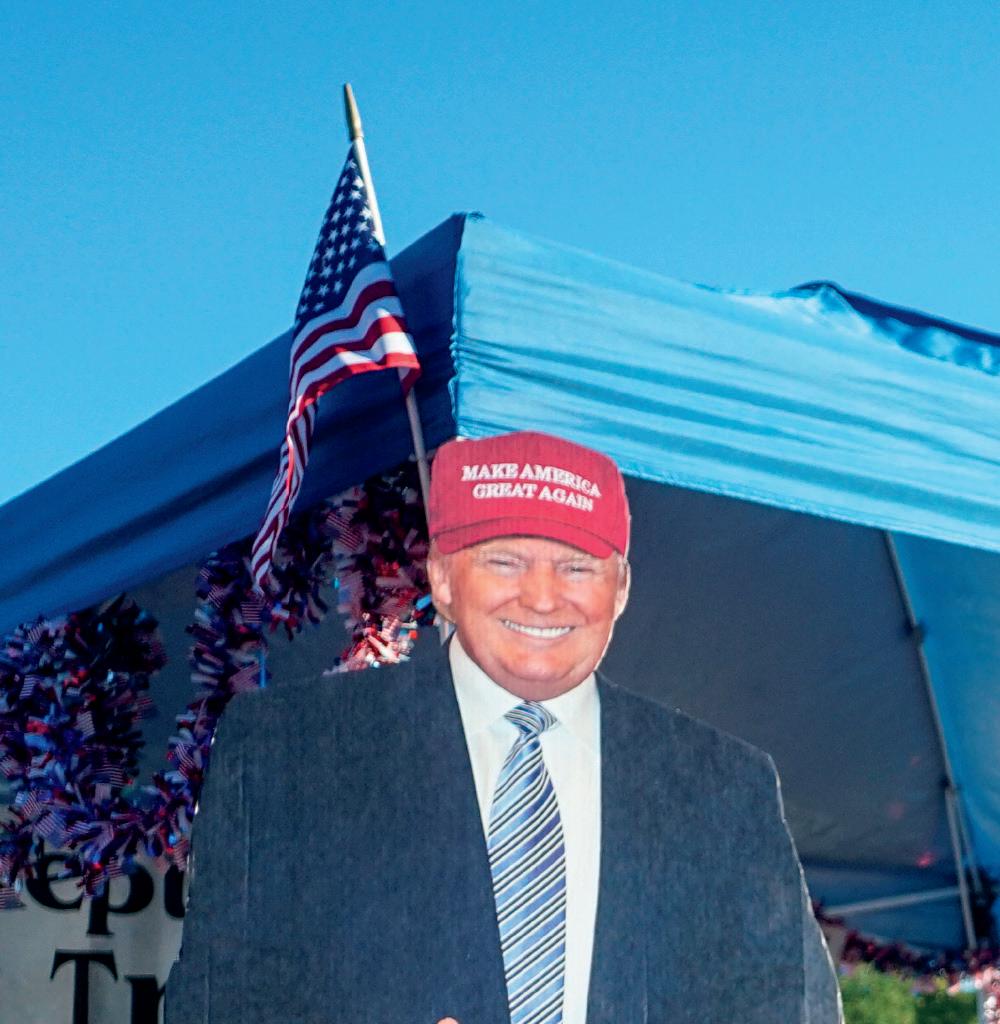
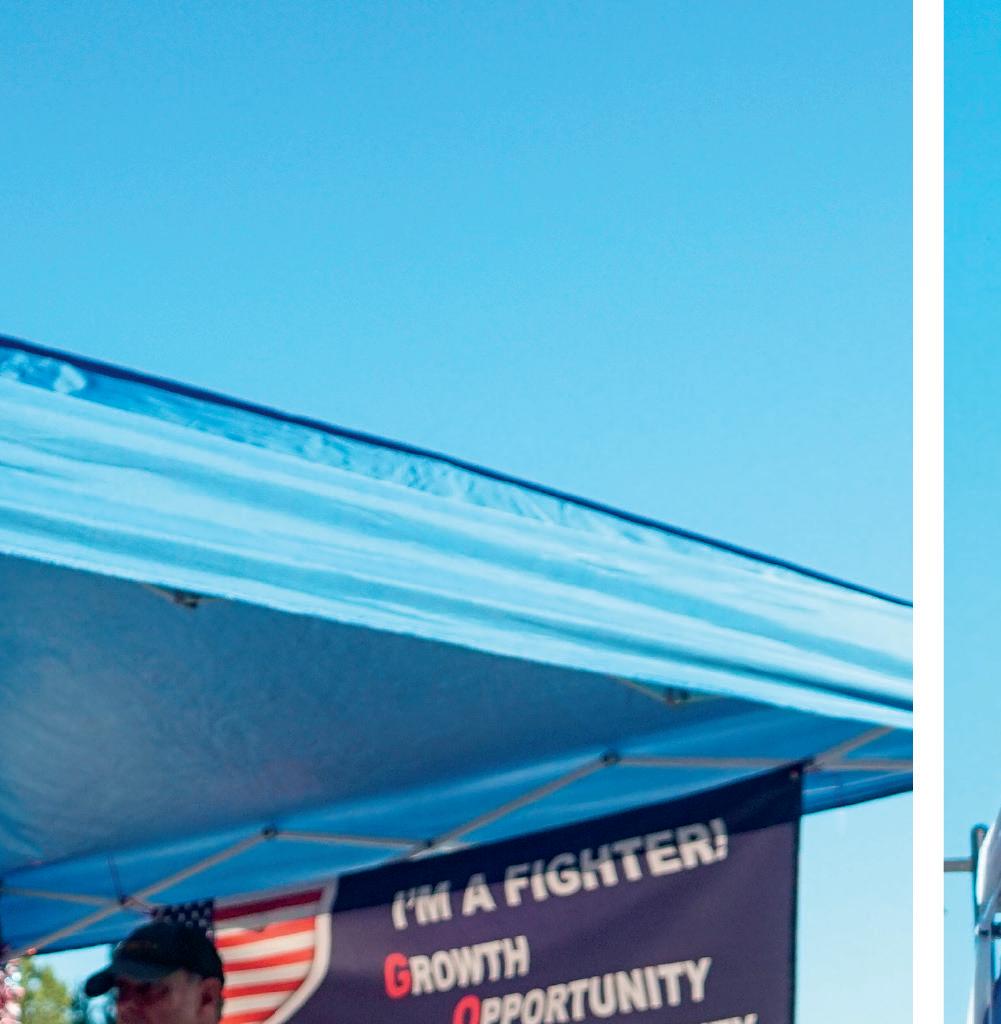

day before, senior George Bové dropped o a mail-in ballot at a polling location for the election. He joined thousands of young voters across the country who cast a ballot for the rst time.
“I feel like we can do a lot more change than we think we can, even us who are 18, 25; high schoolers and college students,” Bové said. “If I think back to 2020, I have opinions about the 2020 election — even the 2016 election. But with that, it’s like I couldn’t really do anything about it so it was kind of all kept to myself. But now that I have a voice
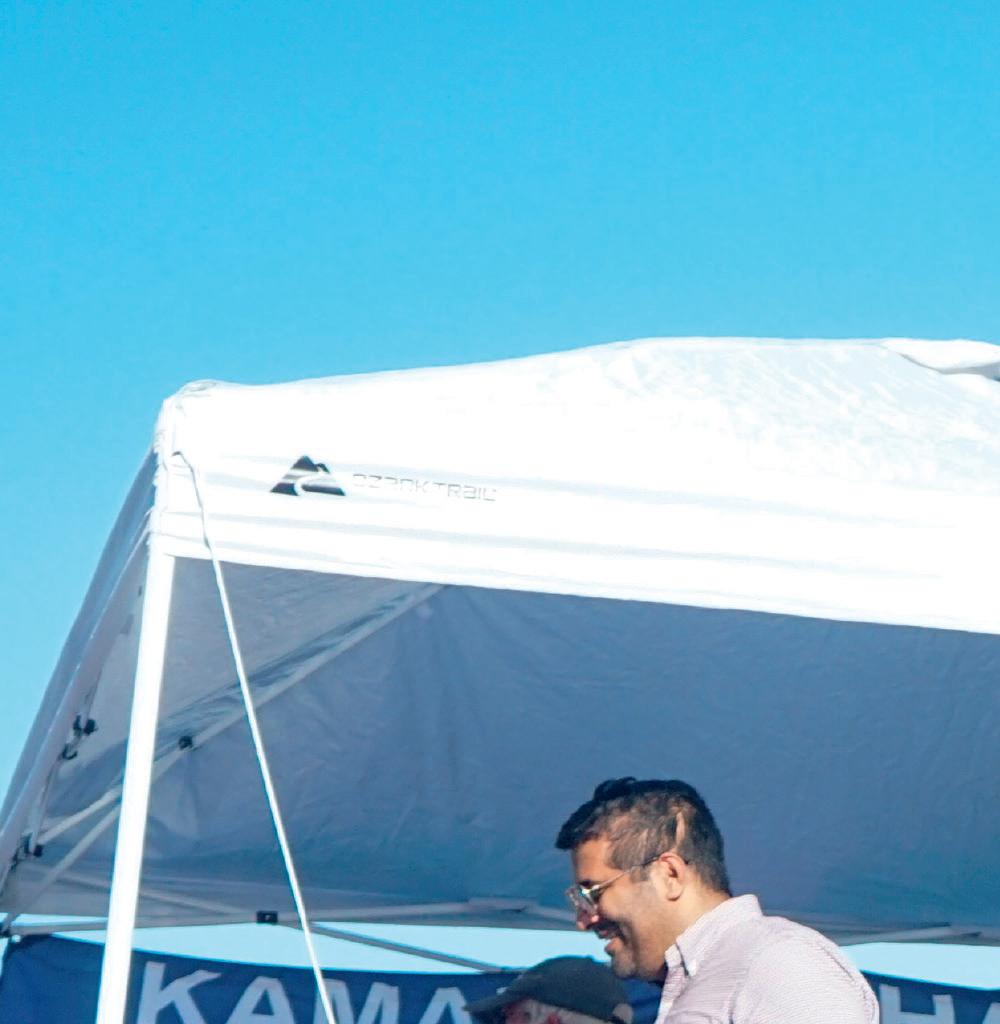




here, there’s a lot that I’m opinionated about.”
Leading up to the election, various students, clubs and local organizations promoted youth political participation through volunteering for campaigns, posting on social media, arranging registration drives and conducting political polls. Starting in September, the Young Democrats club worked with the Pennsylvania Democratic Party to canvass Chester County. Sophomore and club member Sukanya Menon went door to door with other club
members to contribute to causes she nds important.
“I’m not able to vote, but nonetheless, it’s still really important to be involved,” Menon said. “Advocating for others is something I’m really, really passionate about, and human rights is something I’m really passionate about. Even though I can’t vote, there are multiple other things I can do, and canvassing is one of them.”
Similarly, 2024 Pennsylvania Senate District 19 Republican candidate Duane Milne values youth civic engagement. Milne
rst became involved in politics through volunteering.
“It’s just great to see young people take an interest,” Milne said. “I started to be a volunteer for campaigns, and that is what got me interested and got me motivated to become part of the process. Even if it’s not something you do again, if nothing else, you will have much more awareness about politics and government.”
As a Judge of Elections in Tredy rin Township, Carol Clarke is responsible for setting, staing and running her designated polling location, Precinct 630.

The Schuylkill River Passenger Rail Authority (SRPRA) is beginning the second phase of its passenger rail restoration project. Chester, Berks and Montgomery counties formed the informal Schuylkill River passenger rail committee after Congress passed the Bipartisan Infrastructure Law in November
2021. In June 2022, it formally established the SRPRA, which aims to reinstate passenger rail connecting Reading, Phoenixville, Philadelphia and nearby states. The project consists of three phases. Phase one focuses on examining previous attempts to reconstruct railways in the area, as well as developing a project scope, schedule and budget. Phase two involves determining a service
development plan, ridership forecasts, capital and operating costs, operation simulations and infrastructure improvements. Phase three addresses the engineering and design of the rail system and considers its predicted environmental impacts.
Tom Frawley, executive director of the SRPRA, has worked on similar projects in the past and said that the authority has made rapid progress.

“There have been projects where they were stuck in planning for 20 years or more,” Frawley said. “This isn’t like that. We’re not doing a bunch of work to put an interesting report on a shelf somewhere. This is very laser-focused on doing what we have to do to actually get the service running.”
Marian Moskowitz, vice chair of the Chester County Board of Commissioners, said that the overall purposes of the project are to enable economic opportunities for county residents and reduce environmental harm by promoting the use of public transportation rather than personal vehicles.
“This is a really good project, and it’s really good because we’re all rowing in the same direction. We all have the same goals, and our communities each benefit differently from the impact of returning regional rail,” Moskowitz said. “I love partnerships. I think it’s the way to move things forward in a responsible manner.”
The organization will mainly build upon preexisting rail infrastructure across the three counties for the new services, including discontinued train stations and the

THE LATEST DEVELOPMENTS
IN T/E AND NATIONAL NEWS
TESD offErS SupporT groupS To STuDEnTS
This year, students can attend support group sessions facilitated by a Student Assistance Program
Specialist from Caron Treatment Centers. Groups hold meetings once a week for eight weeks and each session lasts for 30 minutes during the school day. The four groups offered are Grief and Loss, Connections, Dynamic Families, and Project Connect.
’SToga rEmovES
frEShman paSSporTS
On Oct. 23, school administration officially lifted the passport system requirement for freshmen. Previously, the freshmen had to have a teacher sign a booklet when attending activities during “Lunch and Learn.” They now have full access to all Lunch and Learn privileges, including the atrium and library.
paTiEnTS rElocaTED afTEr
firE in paoli hoSpiTal
On Oct. 22, a fire broke out in an operating room at Paoli Hospital at around 12:30 p.m. No patients were harmed, but the operating room team was examined and treated for minor injuries. The hospital plans to temporarily divert some patients to other healthcare facilities as they respond to the fire and alert appropriate regulatory agencies.
p
On Oct. 24, Philadelphia Zoo officials and city leaders discussed the Philadelphia Zoo’s largest project in a decade: the update and expansion of Bear Country. Set to begin in 2025, the renovations will include new habitats and improvements for bears, with projected opening in spring 2026.
This year, staff and students have increased club management, advertisement and involvement due to the implementation of “Lunch and Learn,” a reactivation form, a bulletin board and a Schoology group.
At the beginning of the year, the student activities office sent out a reactivation form to nearly 200 clubs to verify if they were operating. It confirmed 118 groups. It asked for “sufficient student interest,” alignment with Conestoga’s mission, an available and willing adviser, no duplication of purpose or activities of other clubs and approval from ninth grade assistant principal and student activities administrator Dr. Nicole Jolly.
“I think the whole club activation at the beginning of this year was good to weed out the defunct ones,” senior and president of Key Club Lauren Wu wrote in an email. “I don’t have any real complaints or concerns.” Peer Mediation created Club Collaboration Group, a new Schoology group where student leaders and advisers can communicate with each other. Additionally, the student activities
office started featuring weekly club advertisements on a bulletin board highlighting the purpose of the group and its meeting schedule.
As clubs can meet during Lunch and Learn, some have experienced a noticeable increase
in participation since the beginning of the school year.
Junior and president of the Muslim Student Association Zaina Sohail plans on using Lunch and Learn to host club meetings. “We have not met during Lunch and Learn so far. The
events that we’ve had lasted longer than 30 minutes so we don’t want to limit those events, but we do plan on having our monthly meetings during Lunch and Learn because 30 minutes is the perfect amount of time for our meetings,”
Sohail said.
Katie Wilson, an adviser for the Disability Awareness and Pillboxes for Patients clubs, feels that Lunch and Learn has benefited the school community, especially as meetings can be more accessible to students who have commitments outside of school.
“I love how the district is trying to institutionalize ways that kids can get to the things that they want to get to and build it into the time when they’re already here,” Wilson said. “You’re here a lot, you don’t need to always be here more.”

This year, Conestoga expanded its dual enrollment program to include five new courses: Human Genetics, AP Psychology, Criminal Justice, Forensics and Sociology. Last year, the school officially signed an agreement with Immaculata, Gwynedd Mercy and West Chester Universities to provide students with dual enrollment course options. The agreement allows students to simultaneously earn high school and college credits by taking Conestoga classes for $400 per college course. Some classes, such as AP Economics which encapsulates both micro and macroeconomics, allows students to attain multiple college credits.
During the 2023-24 school year, Conestoga offered only Accounting 1 and 2 and AP
Economics as dual enrollment courses. The high school submitted the new courses for review, and Gwynedd Mercy validated them.
Since the expansion, Gwynedd Mercy has become the main university partner for dual enrollment because it offers more convenient credit transfer options to a broader range of colleges. It also allows students to take the approved courses at Conestoga rather than going to a college campus.
Conestoga still has an agreement with Immaculata, which sponsors the dual enrollment astronomy course.
Eleventh grade assistant principal Matthew Sterenczak oversees the school’s dual enrollment processes and works with the universities.
“The goal is affordable access to college,” Sterenczak said. “College is expensive, and so if stu-
dents can have the great Conestoga experience with our courses and also be able to earn credits that can save them money going into college, that’s awesome.”
Some students taking dual enrollment courses, such as junior Kushagra Behl, appreciate the opportunity to get more involved in areas of interest and establish credibility in certain subjects. Behl also recognizes the wide variety of credit transfer options there are available. Behl currently takes two dual enrollment courses: AP Economics and Accounting 1.
“It’s a really good opportunity to get some college credits,” Behl said. “It especially helps you save money for college because you get those credits from an actual university. The thing is, it doesn’t really have any extra requirements. The only change is that you’re paying for the credits.”





Starting this school year, TESD implemented a price change for all district school lunches by increasing prices for meals by 75 cents and a la carte items by 6%. The regular school board committee approved these changes during the June 10 regular school board meeting.
“For the last three years, we’ve had unprecedented increases in food (costs) throughout the country,” TESD Food Services Supervisor Dave Preston said. “This year, it was 7.7% for food. The year before, it was 14.4. Pre-COVID, our increases were always between 2% and 3.5% every year.”
Last school year, student
and $6.25 for staff. Breakfast remains free for all students, and those with free or reduced-price meal plans
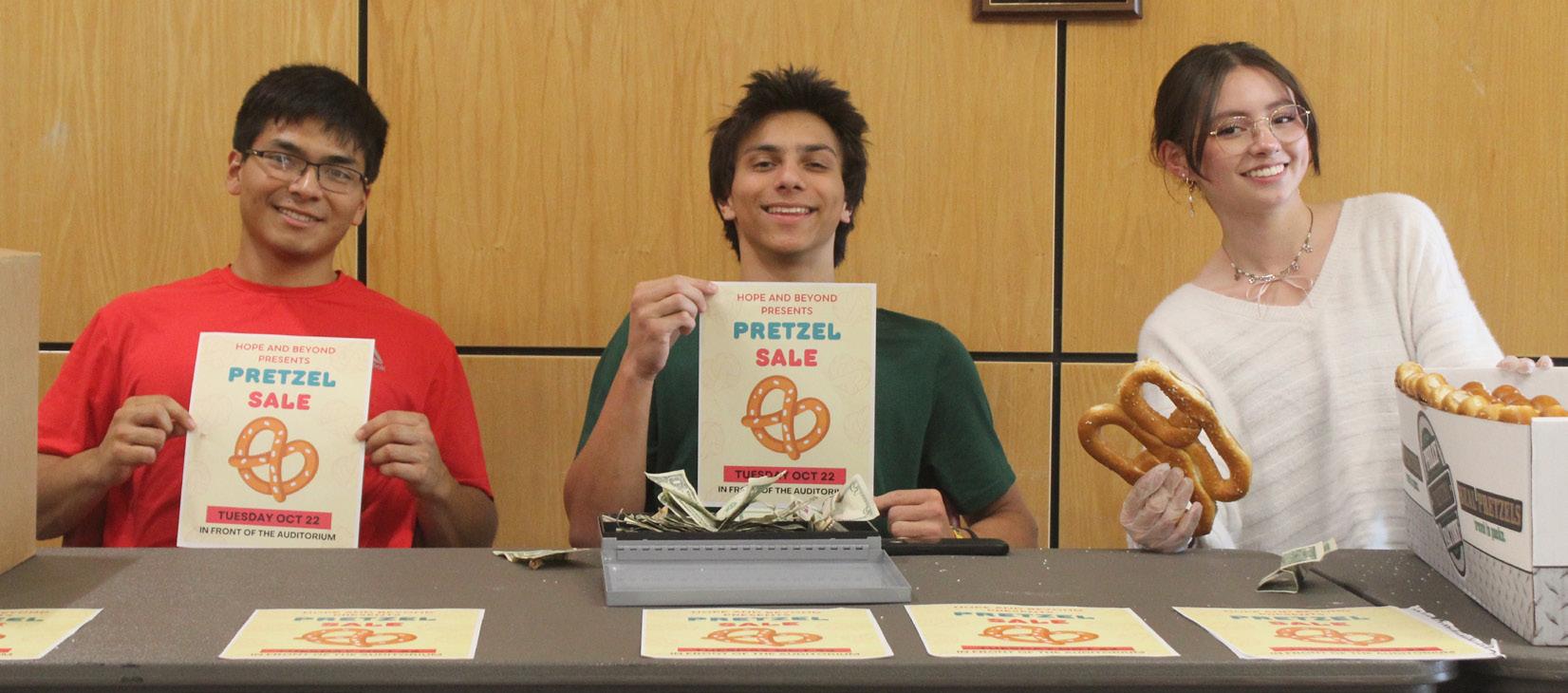
On Oct. 3, Chester County launched Innovate Chester County, an initiative to actively engage residents in addressing concerns regarding affordable housing, public transportation, children’s mental health, veteran services and agriculture. County governance aims to work with residents through volunteer-led workgroups to develop experience-driven and innovative solutions to the concerns.
Chester County Commissioner Josh Maxwell helps facilitate Innovate Chester County. He said that initiative leaders developed the program because they believed that public involvement is essential for effective problem-solving.
“We can get better ideas to solve problems by including the public in these decisions,” Maxwell said. “The public might give us more options to choose from and try to solve a problem.”
The commissioners picked the initiative’s areas of focus, feeling that the chosen five affect all residents. Each workgroup, consisting of up to 20 participants with diverse backgrounds and experiences, is collaborating to strategize within their designated focus area.
Volunteers applied via a form on the county website and had to be at least 18 years old and a county resident.
“The idea is to have lots of different perspectives, so experts are important,” Maxwell said. “When you do things like this, you get two types of volunteers: people who really care about the issue and people who are really technocratic and good at solving problems regardless of the issue.”
The organizers expect workgroup participants to attend virtual or in-person meetings to discuss ideas. Professional moderators, team leads and note-takers will help direct the members, while an initiative steering committee will collaborate with government workers for the implementation of their ideas.
“It is kind of like a King Arthur approach — roundtable where no one’s at the end of the table — and we think that might free up some conversation,” Maxwell said. “We want this to be worth people’s time.”
To match participants with roles that suit their skills and passions, the workgroups will have a larger number of members in the beginning before reducing to a more fitting number.
“The workgroup is going to be big to start, where people are
going to fall off, and we’ll split up the groups to work on specific problems that they’re interested in. It’s going to be kind of fluid,” Maxwell said.
As part of the initiative’s mental health focus, leaders are open to collaborating with schools and creating county youth mental health facilities.
“A potential result is that we’re going to do two things: create a behavioral health core and a behavioral health hospital for kids here in Chester County,” Maxwell said. “To the degree schools are interested in working with mental health with the county, we would certainly be interested.”
Junior Venu Dhanabal, president of mental health awareness and advocacy club Hope and Beyond, appreciates the initiative focusing attention to mental health issues among youth.
“I think it’s very important for mental health specialists to be involved in local governance because currently, the hardest part of helping students with their mental health is making them aware of all the resources they have,” Dhanabal said. “Getting specialists involved in community gathering efforts and workgroups can help with that.”
continue to receive free lunches. After considering the country-wide increase to food supply costs, Preston prepared and presented a budget containing the price increase to the finance committee on May 13.
TESD relied on Supply Chain Assistance (SCA) funds to maintain prices over the last few years.
Distributed by the U.S. Department of Agriculture’s Food and Nutrition Service agency, the fund helped schools, such as Conestoga, participating in the National School Lunch Program or School Breakfast Program address ongoing supply chain challenges by providing relief funds.
“Last year, we received about $163,000 from the federal government to offset our increased cost. The year before, it was like $173,000, and that all ended this past June,” Preston said.
“Without the assistance, we would have lost over $200,000.” Preston said that the TESD food services department receives no tax dollars. The program operates from a separate fund than
the school district and often seeks a small surplus of money, mainly from lunch and breakfast revenue, for new equipment replacements.
“We only raise prices when we absolutely have to. We want everybody to eat,” Preston said. “But it’s a different time right now. We’ve never had a 75-cent increase (as long as I’ve been) in the business.”
Some students have already experienced the effects of the increases early into the school year, especially for those who often buy lunch, such as senior Sabrina Look. She feels that the 75-cent increase has caused her account balance to noticeably decrease.
“I put a bunch of money in my school account for the beginning of the year, but it’s barely the beginning of October, and I’m already in the negatives in my account because of the 75 cents,” Look said. “I’m wondering if I need to change what I get and possibly get something that might not be as good for me just to save money.”

High school alumni establish independent initiatives, expand efforts
While this year’s election marked the beginning of some high schoolers’ political journeys, former students have continued to be involved through their own organizations.
In 2017, Jahnavi Rao founded New Voters as a club at Conestoga to engage high school students in the voting process. The organization has since grown into a national nonprofit focused on encouraging youth political participation, running nonpartisan voter registration drives and establishing branches in high schools across the country.
As a junior, Rao felt disappointed with the low voter turnout among eligible Conestoga seniors after the 2016 presidential election, which inspired her to start the club.
“My first thought was, ‘That’s so frustrating. I would have done anything to be able to vote, and you could and you didn’t,’” Rao said. “But I think my second reaction was that these people care about the election as much, if not more than I do. They care about the future of this country as much, if not more than I do. These are
Rao has found that youth-led initiatives are effective at increasing political engagement.
“I think that the biggest thing I’ve learned is that young people have so much capacity and inherent knowledge of many things, but especially how to mobilize their peers,” Rao said. “If you want to mobilize high school students to do something, high school students are the best people to do it because they have the tools, they have the understanding of their community, they have the connections, they have the language.”
A few miles away, 2024 Great Valley High School alumnus Lucca Ruggieri co-founded Patriot Polling as a junior after observing inconsistencies and problems with past election polls. According to its website, Patriot Polling is the first U.S. polling firm created by high schoolers. It has since expanded, now employing 10 analysts and conducting cold-call surveys to compile data.
Ruggieri also served as the manager for Republican Neil Young’s 2024 campaign for Pennsylvania’s 6th Congressional District. After hearing that his former middle school teacher was running for office, Ruggieri reached out with an offer to help and eventually became the campaign manager.
“I think if you really want to have an impact, the way to do
speak for themselves. You’re not really going to get anything done by standing around on a picket line, but you can if you have the ears of people with legitimate political influence.”
While developing Patriot Polling, Ruggieri faced criticism for being a younger figure in a field dominated by older and more established professionals.
“I got a lot of flak in the media for being young, a lot of personal attacks. What I learned is how to weather the storm,” Ruggieri said. “I think there are a lot of really sharp, hardworking young people who are out there and want to prove something and will do — maybe not just as good of a job — but even a better job than established political people.”
Social media fuels political discussion, youth react
Outside of official clubs and organizations, students have continued to be engaged in the election through the creation of and interaction with social media content. According to a 2024 study by Pew Research Center, 71% of U.S. adults ages 18 to 29 often or sometimes get news about local government and politics from social media, compared with 36% of those 65 and older.
During the 2024 presidential election, there was an emphasis

what New Voters was created to address at a micro level at Conestoga.”
Since its creation, New Voters has worked with student leaders in 39 states. Through her work in the organization,
not a bad thing to get involved in an issue that you’re passionate about, but I do think that working within the system is easier, and I think the results
on social media content, both created independently and by campaigns. Political advertisers spent more than $619 million on Facebook and Instagram advertisements, according to research jointly conducted by the Brennan Center, OpenSecrets and the Wesleyan Media Project. For the first time, the Republican

and Democratic Parties invited roughly 100 and 200 social media influencers, respectively, to create content at their 2024 national conventions.
Senior Deekshitha Anandham, a Young Democrats and New Voters leader, emphasizes that political social media posts can encourage youth civic engagement.
“I think mostly they have been helpful because they’ve been advocating towards a younger audience,” Anandham said. “I feel like it’s a very creative way to campaign, and it’s been successful — millions of likes, millions of followers. In that way, I think it’s very good because it’s allowed the younger generations to be exposed to this kind of campaigning, political sphere and the candidates.”
As a U.S. government teacher, Blake Stabert has concerns about how online content can negatively affect users’ perception of politics.
“So much of what happens online is toxic and negative or manufactured in ways to make us feel certain ways. I don’t think it fosters a genuine desire to be a part of (politics),” Stabert said. “More often, it angers and riles us up and makes us disenchanted.”
As a new voter, Bové saw political content from social media platforms, such as TikTok and Instagram, leading up to the election. He said that it played a role in determining the party he would vote for and that it can both promote and discourage youth political engagement due to social media’s personalized algorithms.
“With social media, you’re able to create this shell of what you want to see. So if somebody isn’t particularly politically active — and it’s not an election season and it’s not a ton of political content going around — if they decide not to interact with that content, they’re not going to get it,” Bové said. “But with other people who are politically active, they’re going to get a lot more content that’s based around (their interactions).”
“It’s an important time in our country, and I think people are realizing that. That’s why they’re coming out to vote,”
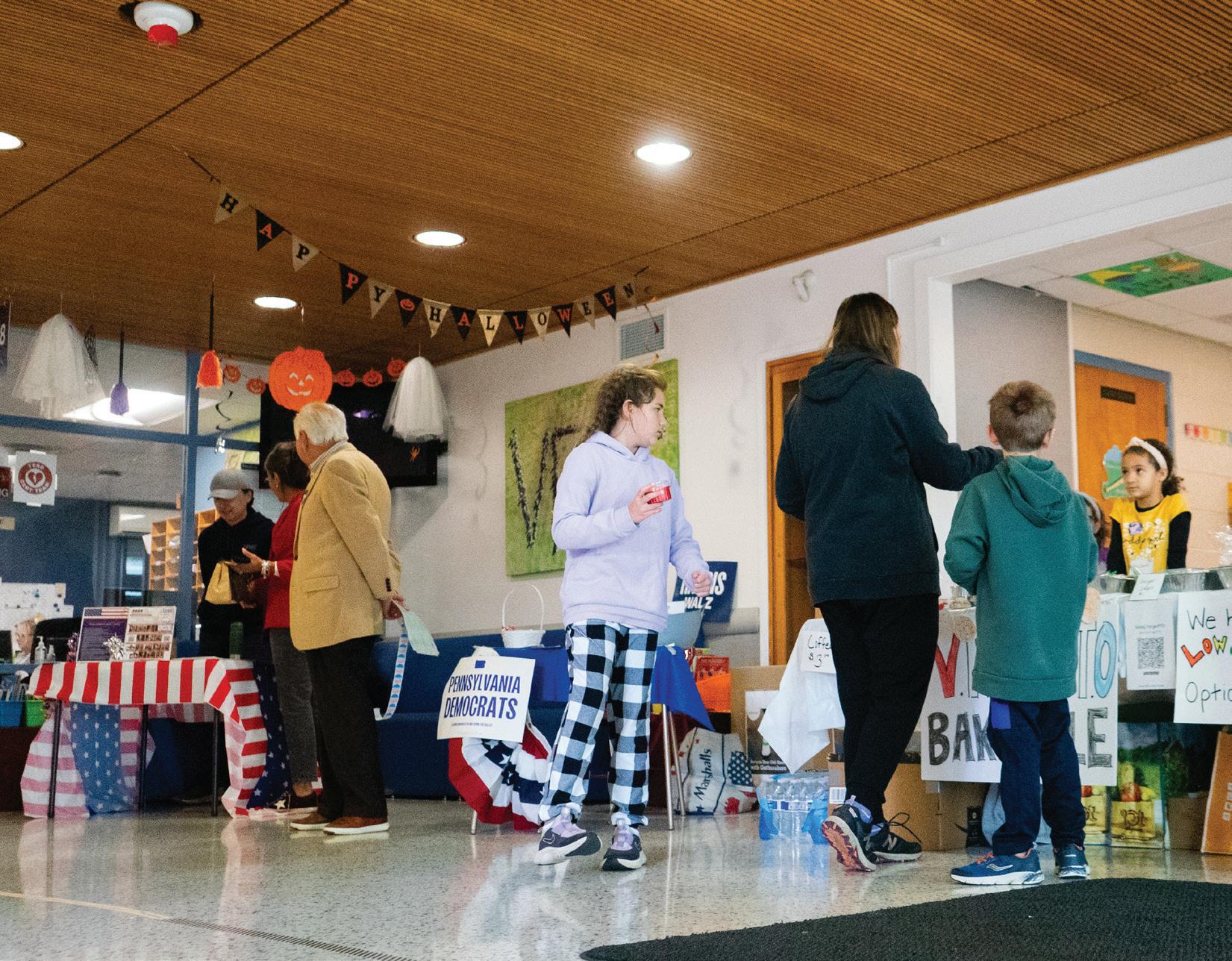
i-Ready Diagnostic Assessment this fall as part of the district’s ongoing implementation of K-8 math benchmark tests by the 2027-28 school year.
In the 2022-23 school year, district math curriculum supervisor Dr. John Mull and the math standing committee, a group of staff members who

routinely review the district’s math curriculum, discussed the benefits of implementing math benchmarks that assess a student’s math knowledge.
Mull feels that in addition to the current unit-based and standardized state assessments, the benchmarks help provide more information to teachers about their students’ progress.
“Teachers see reports of actionable data of (what students know), which helps them understand needs and with planning instruction,” Mull said. “An advantage to this is I can make actionable decisions during the year (if I was a teacher), as I know what’s happening in my classroom. When I see the results in my class, I have better contextual understanding.”
Since the 2022-23 school year, the then-newly created math benchmark committee, consisting of Mull and various math related staff, has met to assess potential math assessments based on each grade’s needs, choose which ones to pilot and determine what tests to administer officially.
In each elementary school, at least one first and second
grade teacher administered a potential benchmark to students twice during the 2023-24 school year. At the end of the year, teachers provided feedback on the piloted tests, and the committee chose the assessments that first and second grade classes across the district are taking this year: Renaissance Learning’s FastBridge earlyMath Assessment for first graders and Curriculum Associates’ i-Ready Diagnostic Assessment for second graders.
Linda Krause is a math support teacher at Valley Forge Elementary School and helped students that used the pilot benchmarks last year.
“I get the reports also, so then I can look at students that might need to have some support in a class,” Krause said. “It helps us to target whatever skills we might want to be working with those students. It does have some materials that we can use to help us, suggestions of materials, and then I also can use curriculum materials.”
The committee will go through similar processes when choosing the assess -

ments for higher grades. New Eagle Elementary School teacher Heidi Waterman is piloting a math benchmark test for fourth graders. She hopes to use the results to assign students to groups based on what overall knowledge they need support on.
“It’ll be nice for us to see that breakdown of skill and where the kids were successful and where they still need help compared to the chapter tests,” Waterman said. “I
think the kids will be getting a lot more questions than just their 12-question chapter test.
I’m hoping it gives a more indepth analysis of what they know and don’t know.” Students take the official benchmark assessments three times per school year during the fall, winter and spring.
“We’re excited to see, to learn from this,” Mull said. “We want it to be worth the class time and what we can learn to do.”

4 e SPOKE
Vanessa Chen Sta Reporter
In fall 2022, former Conestoga English teacher Emmy Talian invited some of her former students to join Write4Change, an initiative started at the University of Pennsylvania, where she was a doctoral student. Two years later, these alumni, along with current Conestoga students, are leading what is now a global online initiative promoting youth writing and research. University of Pennsylvania Graduate School of Education professor Amy Stornaiuolo founded Write4Change over a decade ago. In 2022, the organization moved online, primarily to Discord, a social networking app. Currently, the organization is divided into three sections: literary magazine Network of Visionary Artists (NOVA), a research fellowship program, and a "change team" focused on activism in social media and the relationship between writing and AI. Write4Change hosts Discord events, such as game nights and career discussions, and participates in events such as the annual American Educational Research Association (AERA) conference.
“ e main reason I was interested in leading this project was because I had a really good time at ’Stoga on e Folio,” Ajitabh said.
“We just want to provide an outlet for youth to share what they love to create with the world. I remember when I was in high school, (and) even now, it feels very intimidating to be in the world and share your art with people, especially since so much of art is made by adults. So that’s kind of the point of NOVA.”
Another important aspect of Write4Change is fostering an online community of writers. 2024 Conestoga alumna and University of Pennsylvania freshman Ella Lucarelli helped with the rst phase of research on building a successful digital platform for Write4Change. Although she is no longer involved, Lucarelli believes that Write4Change signi cantly impacted her life and hopes to get involved again in the future.
We just want to provide an outlet for youth to share what they love to create with the world. I remember when I was in high school, (and) even now, it feels very intimidating to be in the world and share your art with people, especially since so much of art is made by adults.
Sunny Ajitabh 2023 Alumna and NOVA editor-in-chief
NOVA is a fully digital magazine open to all youth writers and artists. Ajitabh introduced her sibling junior Ayr Ajitabh to Write4Change, and they now serve as NOVA’s supervising art editor and conduct research through Write4Change.
2023 Conestoga alumna and current Rutgers University sophomore Sunny Ajitabh was a senior when she joined Write4Change as a youth researcher and Discord moderator. She led the development of NOVA and is now its editor-in-chief.
“High school holds your hand a lot, and Write4Change is a great way for high schoolers to get more involved in research or explore their interests in a more unstructured way. ere’s so many people that you can meet (and) talk to, and it’s a great way to outreach to other people,” Ayr Ajitabh said.
“It was really cool to work with so many people of all di erent ages, from all di erent backgrounds and from all different countries, and just get to know how we can all come together through writing,” Lucarelli said.
“Now that I’m in college, it’s crazy how many people I’ve met from all over the world. Wri-
te4Change was my rst time working with people outside of just my high school, and it’s allowed me to have a lot of rich conversations now.”
Write4Change’s research is currently focused on AI’s impact on writing. 2024 Conestoga alumnus and University of Pennsylvania freshman Andrew Yao, joined the organization as a junior in high school and now leads some of the AI research. He discussed the transition of writing from before the COVID-19 pandemic and new technologies is a key part of Write4Change.
“Being able to create a community where people from
Rajan Saha Sta Reporter
On a busy Saturday afternoon in Philadelphia, the sounds of a guitar and singing cut through the noise of the streets. Passersby catch glimpses of Conestoga seniors Celine Luo and Penelope Valenti playing songs at Rittenhouse Square. Luo and Valenti went to Rittenhouse Square, a public park in Center City on Oct. 3rd to sing and play various songs on guitar. The two started playing together because they wanted to try something new for their senior years. In July, they created a band called the Rollie Pollies, and in August, they practiced different songs to play at Rittenhouse Square.
“Both of us are interested in playing music post-high school with other people, publicly or privately. We (decided) we should try and start getting used to that and not be scared of public spaces,” Luo said. The two chose Rittenhouse Square because they wanted to perform in a place with people they did not know to reduce performance pressure. Valenti explains the benefits of being in a new, crowded place.
“ ere's a lot of people around” Valenti said. “You just meet a lot of interesting people.” Both seniors switch between playing guitar and singing for their performances. Luo has been
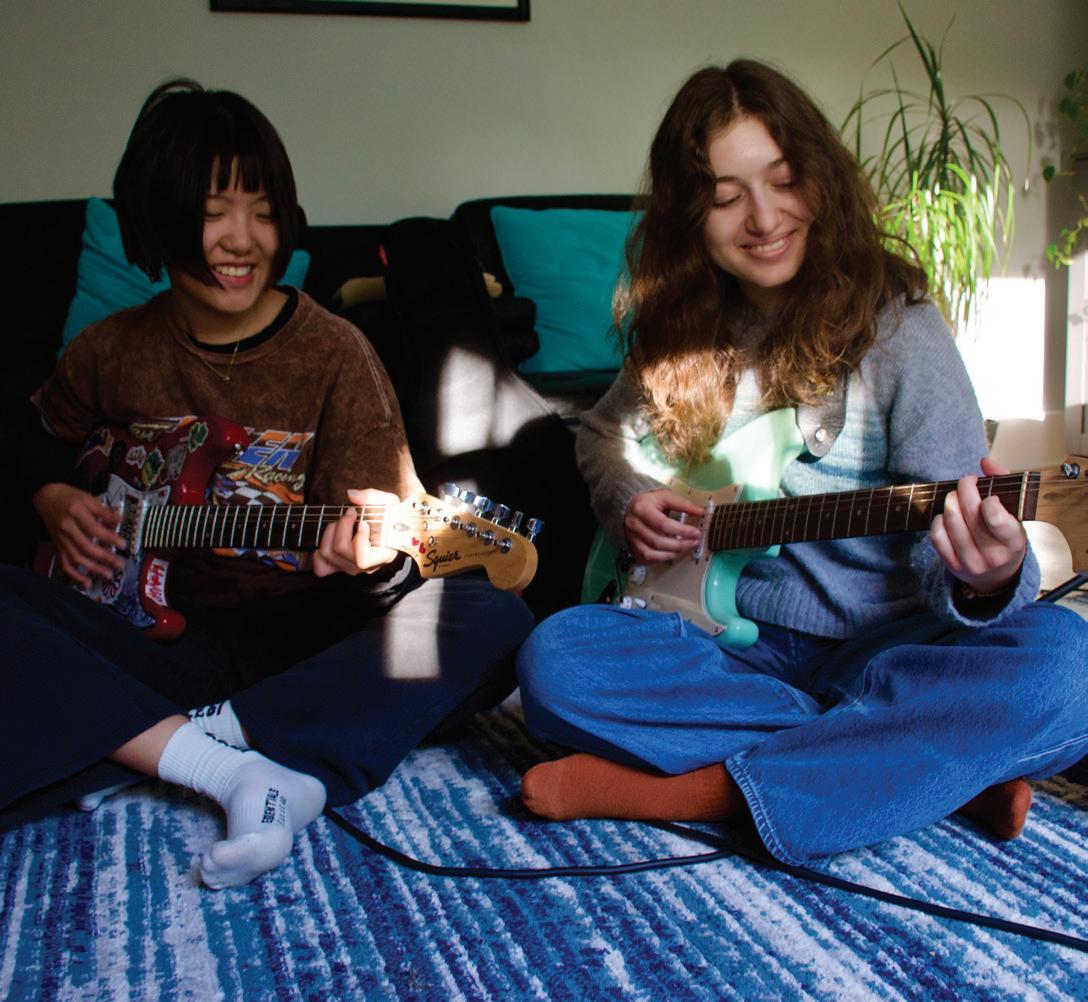
playing guitar since her sophomore year and ute for the wind ensemble at Conestoga while Valenti has been playing guitar since seventh grade and played at School of Rock for two years.
While playing at Rittenhouse Square, three musicians, ranging from trombone to guitar players, came up to Luo and Valenti to talk to them while performing. They complimented them on their songs and made small talk with them.
"I like how random people walk up to talk to us. It’s fun interacting with people who
“Theirs” are big, boring, and repetitive.
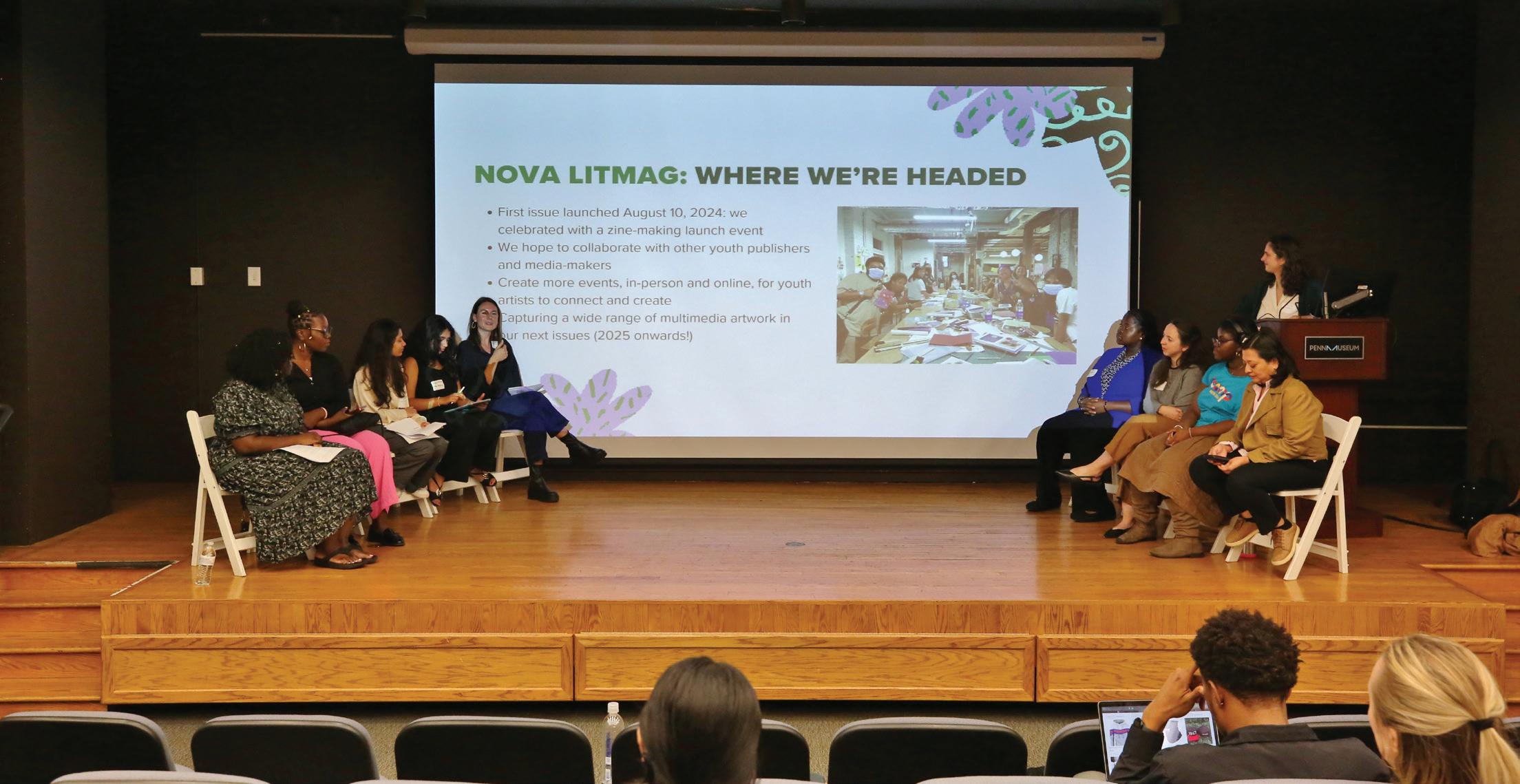
around the world can interact and share their writing without any censorship is really important. (Write4Change) provides a platform for youth to share these more sensitive topics but at the same time brings together multiple generations of writers to interact within a space that isn’t traditionally observed,” Yao said.
In the near future, Write4Change plans to continue its focus on AI and writing, as well as expand its online reach and community membership.
“I hope we do more intergenerational research, because this space has been so important to me not as a student, but as an actual human being in the real world,” Sunny Ajitabh said. “In high school, I was like, ‘Oh, I’m just a student, I’m just a kid. What do I have to say?’ But (Write4Change) has definitely helped me realize that we do have things to say. So I hope we can bring in more youth to the community and help them realize the same things.”


Zara Samdani Co-Managing Editor
Squeezing in on a tight Sunday night reservation, I opened the doors of Fattoush Mediterranean Cuisine in Malvern to a warm and inviting hostess greeting guests and walking them to their tables. By 5 p.m., nearly every seat was lled in the stylishly furnished restaurant.
The interior was beautifully decorated with intricate paintings, stained glass windows and brightly lit floral candles, creating a charming and inviting ambiance. The overflow of tables provided ample space to enjoy the unique Mediterranean cuisine.
the interior had a satisfying saltiness, and the crumbled feta cheese created a delicious creamy texture. The rice was perfectly cooked and seasoned, providing a hearty and comforting accompaniment to the wrap.
As a side dish, I decided to try the fattoush salad. The pickled tomatoes were exactly as advertised — spicy! The tangy, vinegary flavor was a perfect balance to the crunch of the lettuce. The salad was made with a smooth and velvety sauce that was loaded with five different spices, creating a decadent and indulgent treat.

say, ‘Hey, that’s dope,’ and I’m like, ‘Yeah, exactly,’” Luo said. Both Luo and Valenti plan to continue performing at Rittenhouse Square monthly and look into possibly playing with college bands or casually with friends in the future.
“It (music) has been such a part of me that I think, even if I ever get to a point where I'm stuck and I'm an office job, I would still come back to that in my life,” Luo said. “I don't think I can get out of it. It's just always been a part of me, and I'll pick it up again whenever I'm bored."
The menu offered a wide variety of dishes, from classic falafels to flavorful shawarma wraps. I began my meal with a hummus platter, which arrived on a pristine white plate adorned with paprika and parsley. The hummus served as a delightful and refreshing prelude to a satisfying meal. Its creamy and smooth texture complemented the subtle tanginess, and the accompanying vegetables and pita bread provided a crunchy counterpoint to the balance of flavors.
For my main course, I opted for the Greek chicken wrap with rice on the side. The first bite tasted like heaven: the thick yet pliable pita bread enveloped the perfectly marinated, juicy chicken breast. The tomatoes and olives in
Although I was quite full after my meal, I could not resist ordering the traditional Lebanese baklava. The dessert was presented beautifully, with a thick layer of caramelized sugar on top of the flaky pastry. The contrast between the crunchy sugar and the smoothly-chopped nuts delightfully soothed my tastebuds. Thin sheets of dough counteracted the sugar, making the overall sweetness just right.
Fattoush, named after a Lebanese salad, serves more than leafy greens. Open from 11 a.m. to 9 p.m., it offers a respectable Mediterranean-infused dining experience with options for everyone. Not including tax or tip, the meal came to a total of $50. While the prices are slightly higher than some other local restau-

the
If



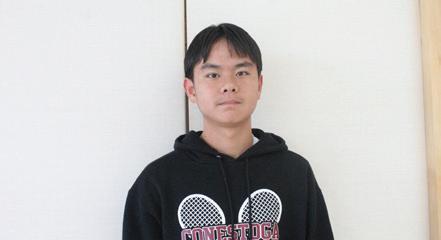
In order to prevent students from using their phones during class, many teachers have implemented cellphone holders into their classes. They expect students to place their phones into the holders at the beginning of class and only collect them once class has ended. Students and faculty share their thoughts on phone pockets.

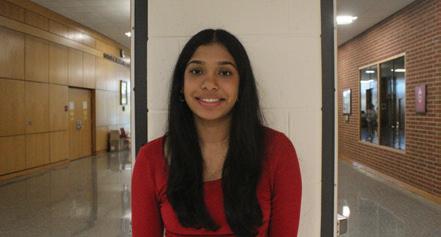

“I




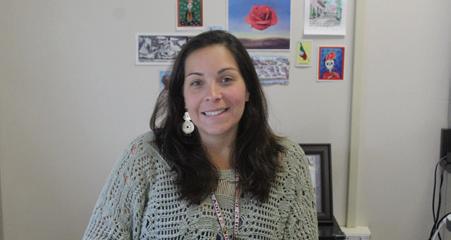
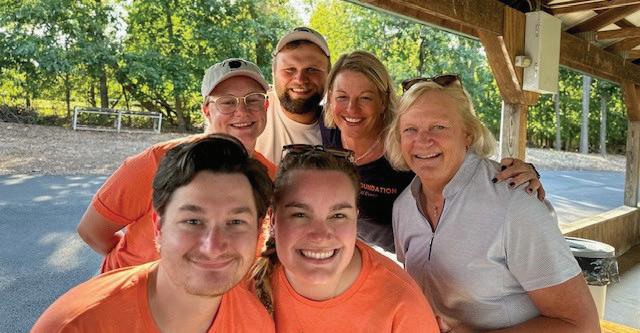

Mareska Chettiar Co-T/E Life Editor
For the past two years, the Niness family has gathered in Gilbertsville, Pennsylvania to host a large golf outing and picnic. The Mark G. Niness Foundation is a 501(c) (3) nonprofit dedicated to giving out two scholarships at Conestoga’s Senior Awards Ceremony, one to a student participating in performing arts and one to a student in athletics. Nominated students receive the Layover Award. The foundation was created in memory of community member Mark Niness, who passed away in a sudden cardiac event in January 2022.
“Growing up, my dad just wanted the best for everybody,” Mark Niness’ son and 2018 Conestoga alumnus Jackson Niness said. “He treated every kid on the field (or) on the stage as his own, and he cheered for them just as much. With the community, he always had a smile on his face, always the loudest guy in the room. But when he spoke, people listened.”
The Niness Foundation hosted its third golf outing and picnic on Sept. 13 at Twin Ponds Golf Course in memory of Mark Niness, who played golf as his main sport. People played in a scramble tournament, with each mem-
ber of a four-person team hitting the ball, choosing the best stroke, then hitting the ball from that location until the team with the lowest score won. “There were over 200 people that ended up showing up this year,” Jackson Niness said. “We’re really just bringing awareness to what ultimately happened with my dad. That’s a big goal for us, but (it’s) a huge event and always a great time.”
The foundation hosts multiple raffles, which raise money for the scholarships and pay the expenses of the event. All raffles were available online for people to participate in, even if they could not make it to the outing. The foundation also accepts yearround donations.
“We do a 50-50 raffle and a jackpot hole, so if the ball enters the green, then you can enter into this 50-50,” Mark Niness’ daughter and 2016 Conestoga alumna Madison Niness said. “This year, for the first time, we included a post-golf event, which was a cornhole long toss, which also raised money.”
Since many members of the Niness family participated in theater and sports in Conestoga, the foundation prioritizes students participating in those activities. The foundation lets Conestoga counselors and coaches
who determine scholarship winners through the Layover Test, a test of character used by employers to determine whether they would spend a layover at an airport with the person they are interviewing.
“Anybody can submit an application and make themselves look good on paper, but we wanted (the nomination) to come from people who interacted with (the student) every single day,” Mark Niness’ daughter and 2020 Conestoga alumna Kennedy Niness said. “We worked with the faculty at Conestoga and determined that it would be best for somebody in the theater department and coaches to nominate a (person) that they felt was deserving of this award.”
In the future, the Niness Foundation hopes to give out larger scholarships, host rst aid workshops and donate automated external de brillators (AEDs) to the community.
“We are really looking into heart health awareness. That was how Mark passed away,” Madison Niness said. “We were told that the only way that he may have been saved after the cardiac event was if an AED had been used on him immediately. We know that there are AEDs in the community, but they’re few and far between, so our hope is in expanding with heart health awareness.”
e time was 4:00 a.m.; standing outside the train station, in a turbulent cloud of white snow, then eighth-grader and current sophomore Calvin Kan prepared to record his daily weather report. A er hours of lming and editing footage, Kan headed to school, where his video aired as part of the VFMS morning announcements. is scene was a regular morning in Kan’s life at VFMS. Inspired by a large snowstorm in 2016, Kan began learning more about weather phenomena and soon developed a love for sharing forecasts with others. When Kan rst started out at VFMS’s TV Studio, he signed
up to forecast the weather, and decided to put his own spin on the job with a video. Kan’s reporting received much support from the community, and soon his reports became a mainstay of the announcements.
“I remember being very surprised that he was interested in it, because I’ve been teaching kids that age for a while, and I don’t think I’ve ever met anyone else that liked doing this sort of thing,” said Amy Schroeder, the technology teacher and director of TV Studio at VFMS. “I just thought it was very impressive that he was willing to put himself through really cold mornings of standing outside in the dark, and all just because he wanted to do it.”
Kan’s passion for forecasting meant he sought ways to improve. At 12 years old, he won a scholarship to attend a week-long overnight weather camp for high school students at Penn State. In the summer of 2023, Kan further honed his skills in Boston, where he attended a two-week long lm camp exposing him to professional broadcasting equipment and training.
“ e amazing thing (about) him is that anywhere he went, he was always interested in the weather,” Tracy Sun, Kan’s mother said. “He will watch other weather reports and do a lot of analysis and forecasting, and he is frustrated when the weather is not accurate.”
While Kan has since graduated from VFMS, he continues

to pursue his love of reporting through Good Morning Stoga, the daily morning announcements for Conestoga, and his social media accounts on Snapchat and YouTube, where he posts weather forecasts, personal lms and news reports. Kan is also developing his own media team, which will help him expand his reporting capabilities.
“It has given me more condence to talk to people and do more extracurriculars. I’ve grown more con dent with myself, and it’s also helped with my presentation skills and public speaking,” Kan said. “I love reporting and being able to talk about certain events. I feel like these memories make a really enjoyable experience.”
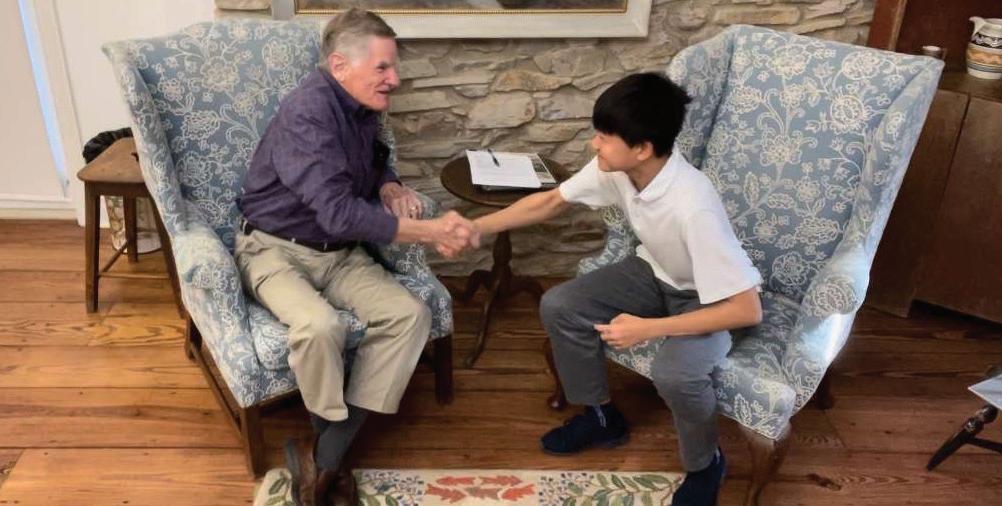
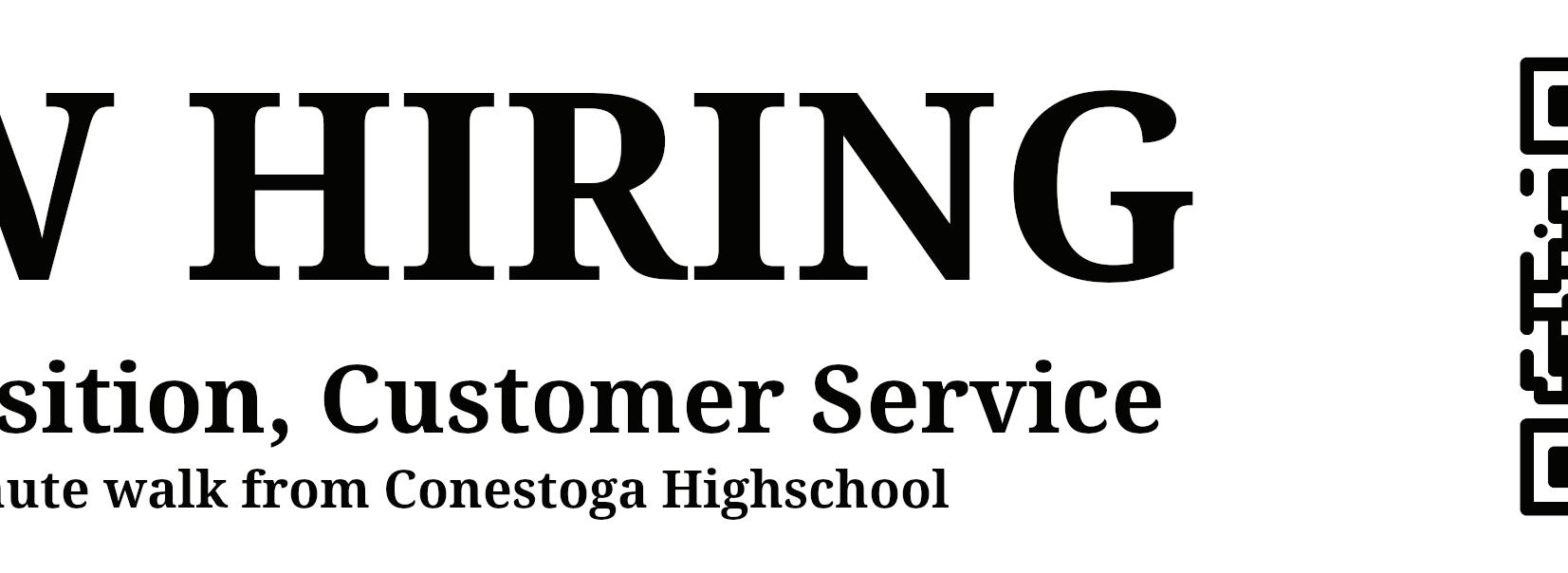

Written by Rowan Chetty and William Simon, Co-T/E Life Editor and Sta Reporter
Designed by Mary Wolters, Design Editor
at Conestoga!
Senior Annagiulia Ferretti, a foreign exchange student from Milan, Italy, is excited to spend time at Conestoga while studying abroad. Ferretti was initially interested in the program because she wanted to experience American high school rsthand after watching American TV shows while growing up in Italy. Ferretti enjoys the opportunity that studying abroad gives her to improve her English and meet new people.


Junior Gonzalo Ruiz de la Peña Canseco is a foreign exchange student from Oviedo, Spain. Inspired by his older sister, who was a foreign exchange student at Conestoga two years ago, Ruiz de la Peña Canseco also applied to study abroad. At Conestoga, Ruiz de la Peña Canseco plays for the boys junior varsity soccer team and is excited for his Coding class second semester. He hopes experiencing American culture will help him become more open-minded.

Junior Sisi Xu plays piano covers of songs from various genres, including soundtracks from Chinese and Korean dramas, on her Youtube channel SisiPiano. Her channel has attracted nearly 500 subscribers since its launch in 2021, with her most popular video gaining more than 62,000 views. She initially posted her cover of Allen Ren’s “Youth Like You” on RED, a popular Chinese social media app. After the video received positive responses and requests for sheet music, Xu decided to create a YouTube channel to share her musical arrangements.
“For me, I wasn’t focused on making my channel popular,” Xu said. “I had different phases (of) songs I liked throughout the
years, and I think (the songs) record the types of music I listen to along the way. When I look back, I can see that during this time, I really loved this song, so I made a cover of it.”
To arrange a song, Xu adapts the music and adjusts the notes to fit the piano. She uses MuseScore, a software that allows users to create, edit and share sheet music. After arranging the song, she records her performance, edits the video on her iPad and tailors the visuals to match the music’s mood.
“I didn’t really take lessons on arranging or anything,” Xu said. “Sometimes the original soundtrack I’m looking for doesn’t have sheet music online to find, and sometimes the song might be new. I decided to make my own arrangement, and now,
I can make it sound how I want it to sound.”
Xu began playing the piano at 4 years old in China, but her family’s move to the United States in 2018 interrupted her hobby. A couple years later, she bought an electric piano, restoring her love for the instrument.
“I didn’t know what to do in my free time without having a piano in my house,” Xu said.
“It was the first time I really felt that piano was something I wanted to continue doing.”
Xu plans to continue posting covers to her channel and pursuing her musical talents on other instruments, such as guitar and ukulele.
“I want to continue doing my channel,” Xu said. “Even if I might not have as much time as I had, I want to continue what I like to do.”
Anvita Mohile and Paige Vachris Staff Reporters
On Sept. 24, Hurricane Helene devastated U.S. coastal states, including Florida, Georgia and North Carolina. In its dollar drive from Oct. 7 to Oct. 11, Peer Mediation asked students to donate to the American Red Cross to aid disaster victims. Members primarily collected money during homeroom, raising more than $1,500 in total. They also collected donations at other district events, such as the HES Trunk-or-Treat and Conestoga football games.
Senior and president of Peer Mediation Charlie Gawthrop, along with Peer Mediation executives senior Chase Niemeyer and juniors Maggie Barnes and Vaishnavi Sriadibhatla, ran the drive.
“We’re trying to make people realize the impact that they could have by just even donating one dollar,” Gawthrop said.
Junior Ava Joseph, a Peer Mediation executive, was part of the fundraising committee. Joseph said the planning process was quick but successful and that communication and collaboration were major strengths among Peer Mediators.
“I think we were able to unite the team pretty well,”
Joseph said. “We had a lot of people volunteer at the football game last week. We have a good amount of volunteers helping out at Hillside (Trunkor-Treat). Just being able to come together really quickly and our communication was a big part.”
Junior and Peer Mediation executive Vibha Besagi created advertisements and promoted the dollar drive around school. She said that prior to the drive, Peer Mediation members conducted research about the hurricane to decide which charity to donate to, ultimately choosing the Red Cross.
“There were some fundraisers and relief organizations (in articles we read),” Besagi said.
“Once we read through them, we decided to go with the Red Cross for our proceeds.”
Peer Mediation members plan on raising money for charity at other events this year, such as Cornucopia, and hope to continue making a difference for those in need.
“We are a group of people who want to help out whenever we can,” Gawthrop said.
“That’s really what Peer Mediation is about. Besides just helping out the school, it is helping out the people that need it.”
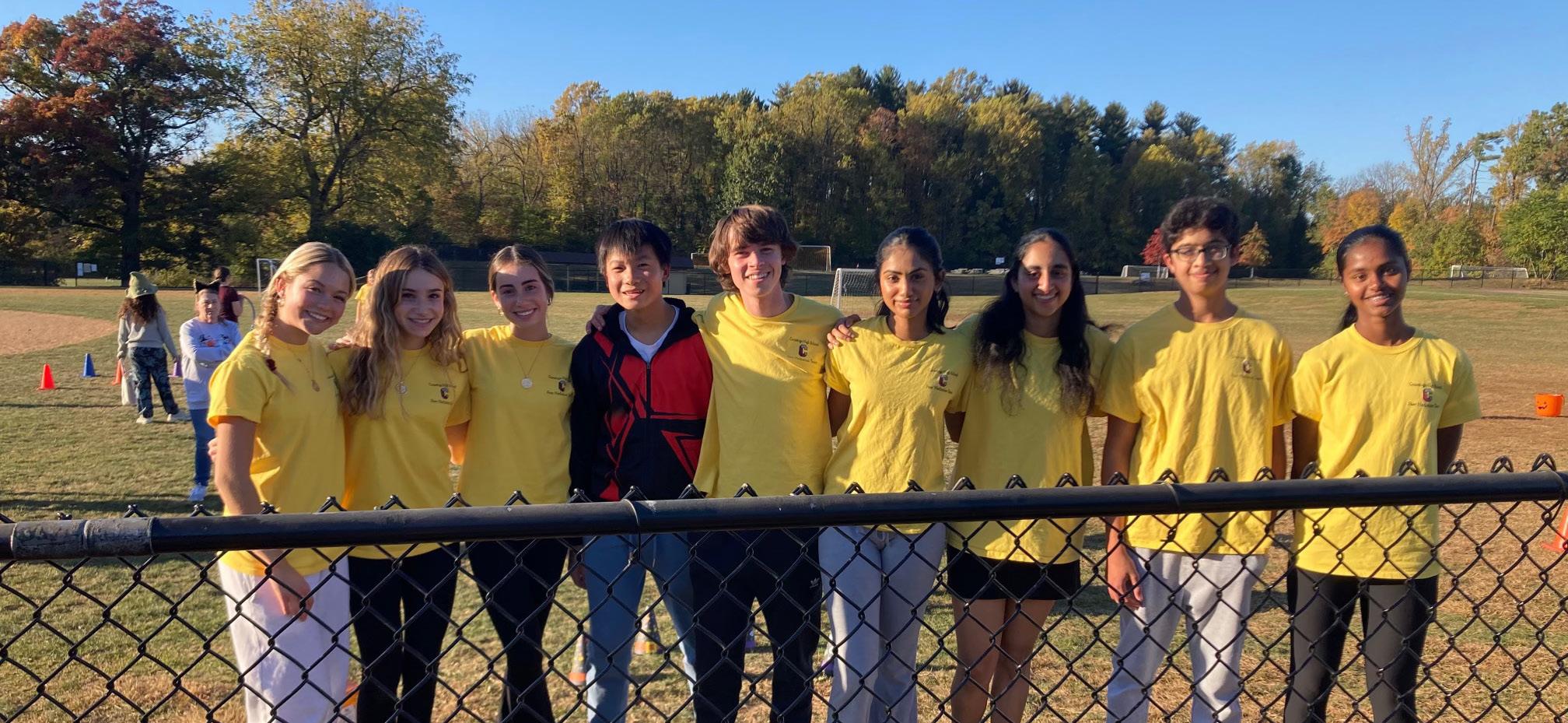

After pursuing a psychology degree at James Madison University, American Voices and Comparative Literature: Science Fiction/Dystopia teacher Dori Madigan went to graduate school to pursue teaching. Now, she is in her 10th year at Conestoga as an English teacher.
Q: What made you want to become a teacher?
A: I love the classroom environment. I’ve always wanted to give knowledge to people and see them understand something that they didn’t understand before. I loved the idea of just being able to completely transform an aspect of a person’s life through education.
Q: Why did you decide to teach English specifically?
A: I’ve always loved English. I’ve always loved escaping into stories, and I’ve always loved just expressing my life experiences through writing.
Q: What was your journey leading up to Conestoga like?
A: My first job actually was out west in Arizona. I moved and started (teaching) elementary school for nine years, and then I taught middle school for about five years. Finally, I moved up to the high school,
and I’ve been (at Conestoga) ever since.
Q: What are the differences between teaching elementary, middle and high school?
A: No one will ever know how hard an elementary school teacher works unless they teach elementary school. Those kids depend on you for everything.
You’re a mother figure, you’re a nurse, you’re a coach, you’re a cheerleader, all of these things besides just teaching them.
Q: What is the most memorable experience you’ve had in the district?
A: I started at T/E Middle School for one year, and I had sixth graders that I taught again as sophomores at Conestoga and that I taught again as seniors. It was crazy to look at them and see how much they grew.
Q : What are some of your favorite things to do outside of teaching?
A: I love to read, obviously. I belong to a pickleball club, so I love playing pickleball. And I’m obsessed with jigsaw puzzles. You can see I have them hanging in my room. I like to do literary-themed jigsaw puzzles for stress relief.
Q: What is your favorite genre to read?
A: I like horror stories. I like mystery. I like all the speculative stuff out there that is super creative and spooky and makes you kind of think about what the world could be like.
Q: What book are you currently reading?
A: I’m reading a collection of stories about Native American folklore, legends and myths. They’re all really creepy and scary.

Q: What do you like to drink in the fall?
A: Hot chocolate. I like to watch my movies with hot chocolate in my bed. Michelle Braverman, sophomore
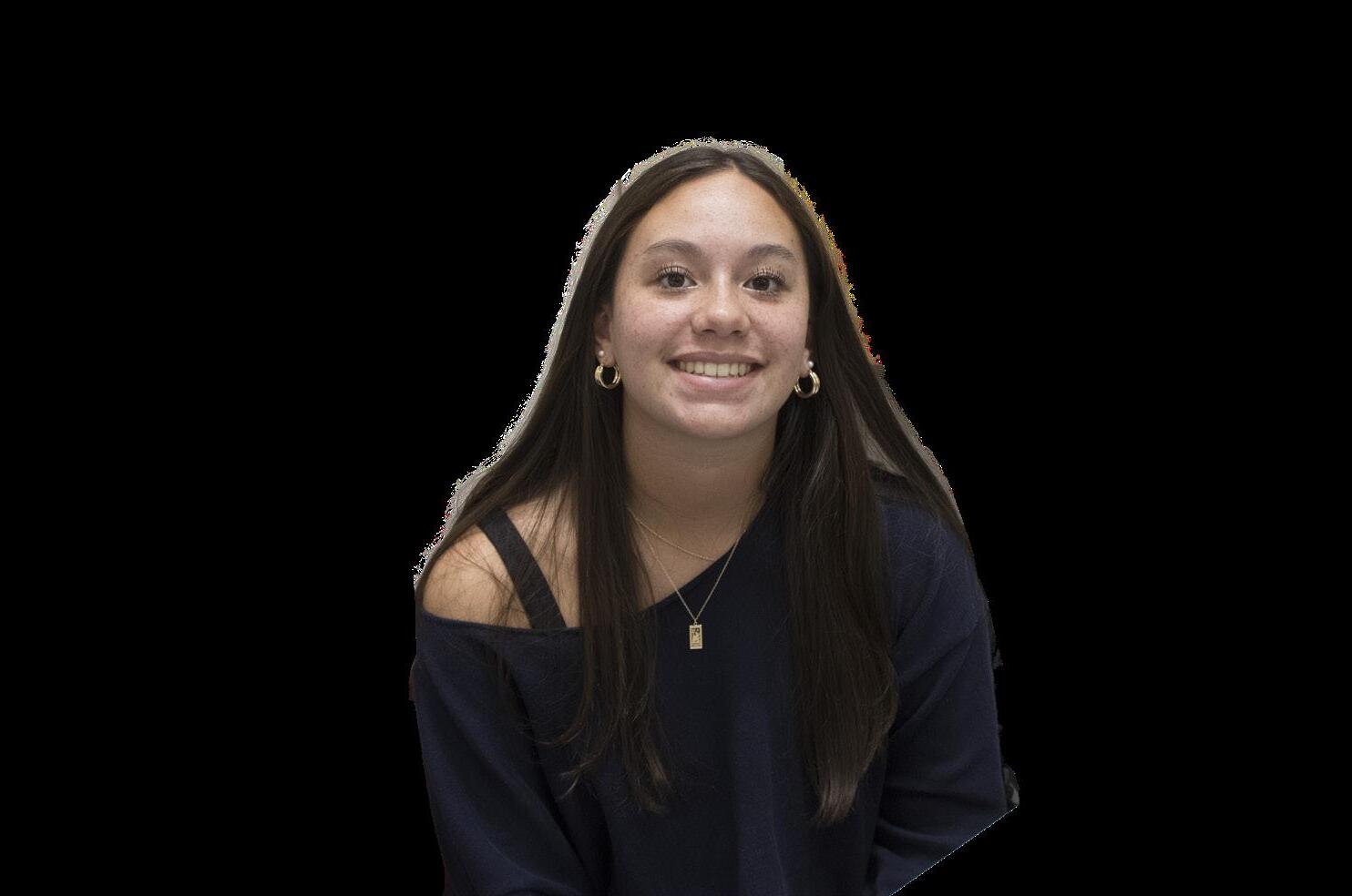
Q: What do you like to drink in the fall?
A: Apple cider, (because of) a sense of fall and I drank it a lot when I was younger. Abby Kilgari , sophomore
Written and Designed by Mary Wolters, Design Editor
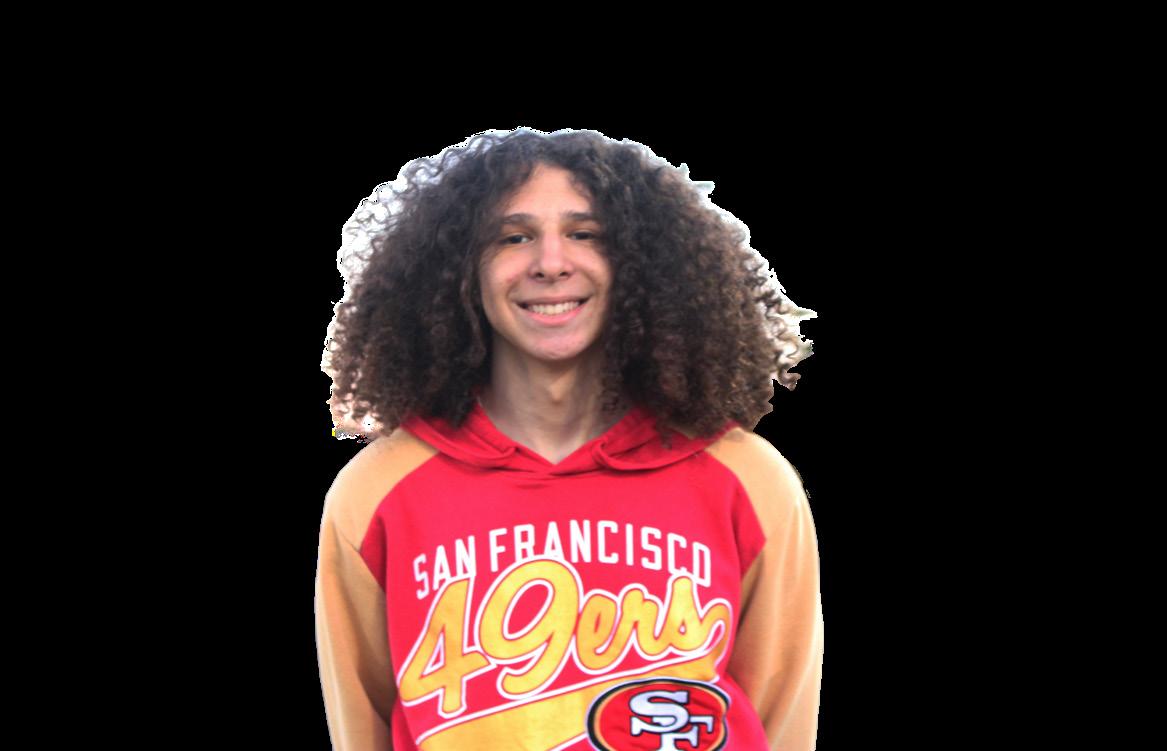
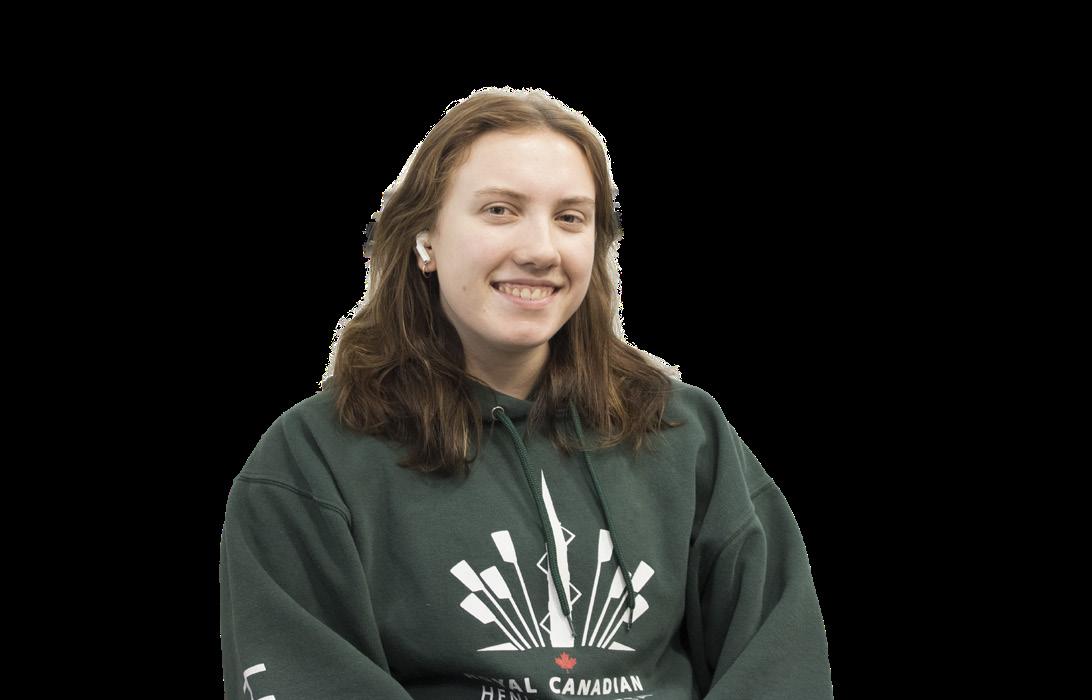
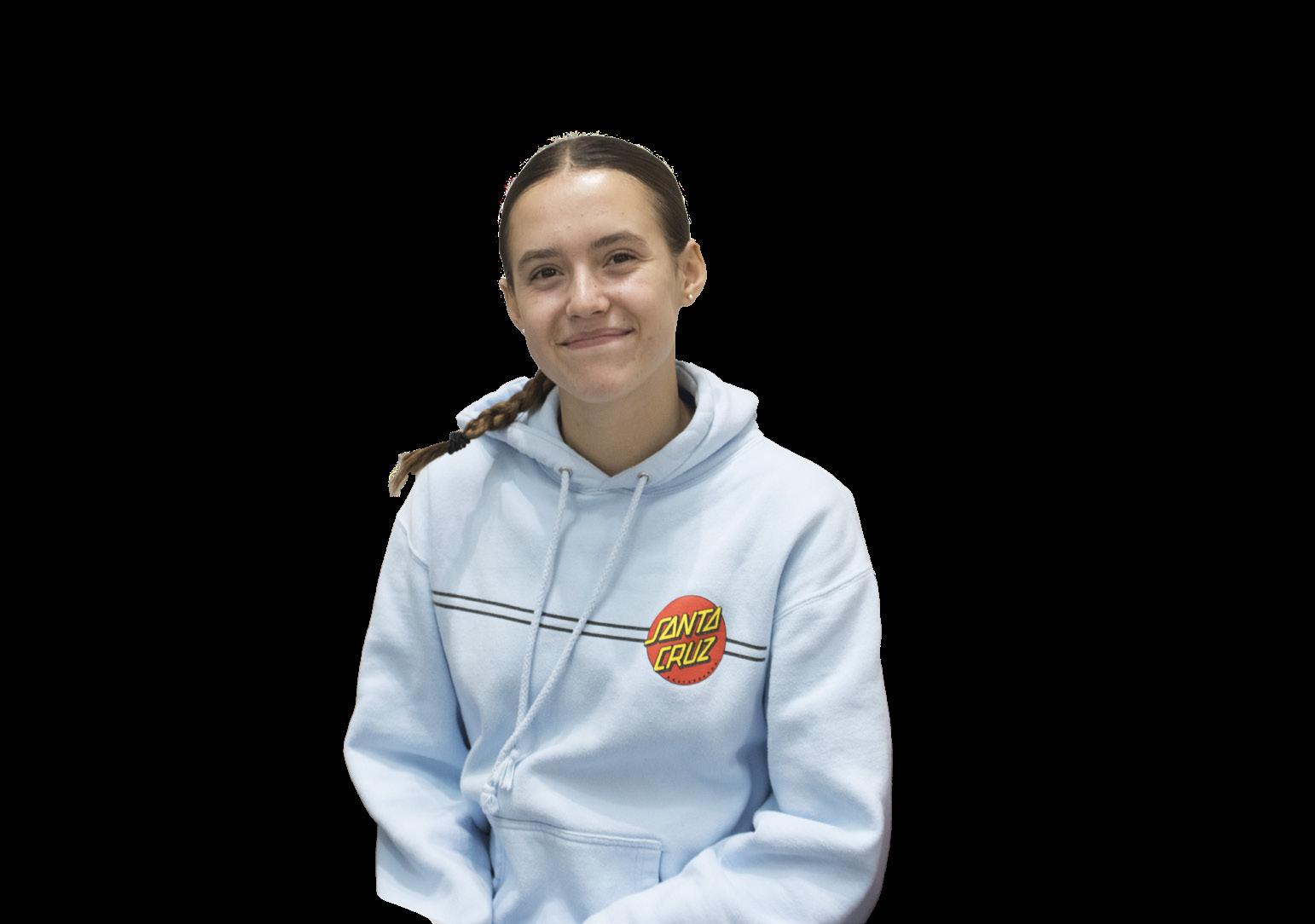
Q: What aspect of fall fashion do you like?
A: I de nitely like the coziness. I feel like being able to wear long sleeves gives you more options than you would (have) in summer.
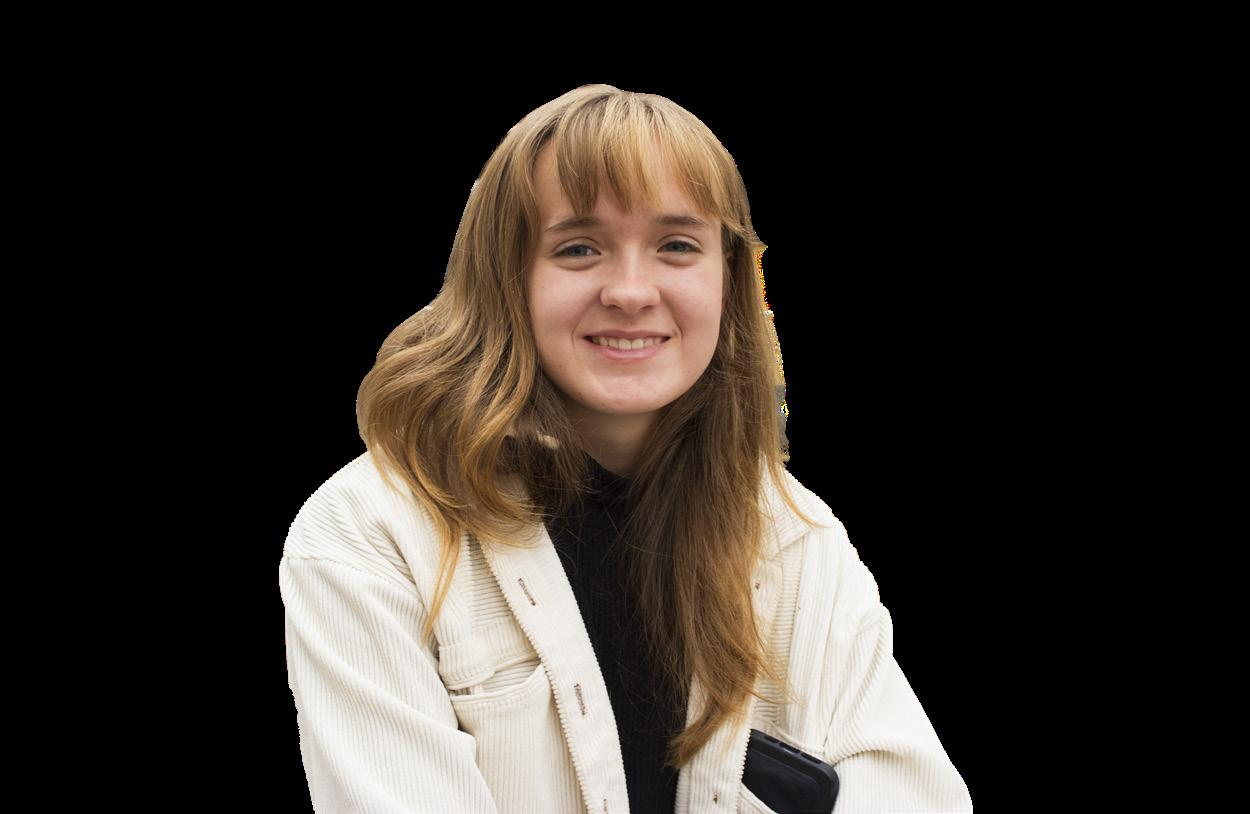
Former guitarist James of The Smashing Pumpkins
Call o , as a project or mission
Constructed by Will Scheidt, Contributing Game Designer
Eng. school in Troy, NY
Spanish aunt
Gov. media moderator
Tiniest amount
"My treat!"
Sound of understanding
Protagonist of Khaled Hosseini's novel The Kite
Runner
"Give ‘em a chance!" ... Or an opportunity you might regret o ering, when 18-, 22-, and 48A get served
Accord
August star sign
Utilize
Q: Why would you recommend others to celebrate Friendsgiving?
A: I think that (Friendsgiving) is a

Animated ghost-hunting great dane
Carly ___ Jepsen (singer)
Thanksgiving vegetable that seems a bit out there
Score that results in 26D
Confucian "way"
Make like a rock on water
Thanksgiving side dish, seemingly not made out of bread after all Superfood berry Doesn't fall, as jeans Snake sound 49th element, one of the softest on the Periodic Table Teacher's abr. For“YOU MADE A TYPO"
Thanksgiving entrée that went a bit too long
Abbreviated word in at least
8 rapper names I can think of
Design descriptor common between the Spirit of St. Louis and a unicycle
Italian nickname
Comcast or T--Mobile o ering
Catalogue of a restaurant's o erings
2 of these letters are found in 37A
Opposite of NNW
Runner of a shop with Pop
Famously long board game
Only slightly, on sheet music
Famous 1926 Langston Hughes poem
Q: What do you usually wear in the fall?
A: In the fall, I wear more sweaters and, I wear jeans year-round even if it's hot outside, (so) it's sweaters and jeans. It kind of depends on the day. For sweaters, I usually thrift them. I go to Plato’s Closet most of the time.

Super long time
Small unit of data
Subtly cunning Tabula ____ (clean slate in Latin)
West coast college directly on the coast (abr.)
Building blocks of the skin's deepest layer
Pre x attachable to -nary, -opsy, or carbonate
Further periods to sports games
Unit of distance in swimming or track
Erie-neighboring state
Snitcher to a cop
Texter's abr. of nonbelief Boolean operator
Snare for a steelhead Stripes on skates?
House cooling system
Itty bitty
Tiniest piece
What an EMT might check for Indian, Chinese, or Russian With 19A, piece of formal neckwear Colleges, in Britain
Thwack!
Thing to order o of a 58A
Nevada city
Percussive part of the marching band
RC monster truck, e.g. The best place to stay in 2020?
Roman god of love on sheet music
Word after“food” in environmental science or before “rule”in calculus
Partner of "tongue”to describe some humor
Cheery response to "How are you?"


In h grade, I got into a physical ght with my classmate. I was the one who had inadvertently initiated the fight, not knowing the consequences of my actions. Both of us faced punishment, but while I had an assigned lunch detention, which I never attended due to the administration forgetting about it, he was suspended for the rest of the week. I was the one at fault, yet it was my peer who ultimately got the short end of the stick.
Many schools in the United States use disciplinary actions such as suspension, expulsion and detention to foster a positive school climate in their buildings, including Conestoga. According to the Pennsylvania Department of Education, there were 157 recorded instances of violations of the Code of Conduct in the 201819 school year in TESD. After School Detentions, Evening Supervised Studies and Saturday Detentions are just some of the disciplinary methods listed in ’Stoga’s Code of Conduct. However, these practices fall under exclusionary types of discipline that ostracize students from the educational setting and ultimately degrade their growth in the long run. Rather than emphasizing these strategies, schools should stress the importance of restorative justice.
holding people responsible for their actions by
of discipline, it focuses on reparation between the individuals who may be a ected by con ict.
clude Restorative Practices (RP) in Policy 5401 as a “consequence for inappropriate behavior.” It

repairing harm and mending relationships. Instead of suggesting the harsher connotation
Review: ‘White Bird’ is your reminder to be kind, always

If you attended middle school a er 2012, chances are you’ve read the coming-of-age novel “Wonder” by R.J. Palacio, which follows Auggie Pullman, a h grader with a craniofacial abnormality, as he makes friends (and enemies) at Beecher Preparatory Academy. On Oct. 4, “White Bird,” a lm that serves as both a prequel and sequel to the “Wonder” lm and novel series, made its American debut in theaters. Based on the graphic novel of the same name published in 2019, the story follows Julian Albans, now in high school, after he is expelled from Beecher Prepatory Academy for his cruel treatment toward Auggie. Unlike in the graphic novel, he isolates himself on the peripheries of his new school in the movie, seemingly unremorseful of his actions. His Parisian grandmother, Sara, feels that it is time for her to share the story of her di cult childhood in
Rating:
France during the Nazi occupation to teach Julian a lesson about kindness.
So begins a ashback to 1940 France in what was once the free zone. Filmed in the Czech Republic, the movie excellently portrays the quaintness of Sara’s hometown of Aubervilliers-aux-Bois as drawn in the novel. Expert cinematography under the creative direction of Marc Forster creates an engaging visual narrative that illuminates the power of imagination and inner strength in the darkest of times.
It’s in these moments the lm emphasizes crucial messages about kindness, sel essness and courage. Tourteau, a boy in Sara’s class a ected by polio, ends up saving Sara from the Nazis and hides her in a barn on his family’s property. It turns out Tourteau’s real name is Julien, Julian Albans’ namesake, a fact that makes Julien’s kindness for Sara that much more powerful. Without question, his mother and father welcome her in, even though her presence poses great danger to them as Nazi militants begin to patrol the town. You can’t help but root for Julien and Sara as they become closer and eventually fall in love amid an unforgiving and cruel world.
While the lm is beautifully directed and contains important
messages, the movie misses a golden opportunity to capitalize on Julian’s redemption arc and its message about kindness at large. A er being moved by his grandmother’s story, Julian helps someone clean up their papers a er having knocked them out of their hands. He also apologizes to a girl he was rude to at the beginning of the movie and agrees to help her hand out yers for the Social Justice Club. However, do these two moments really show that Julian has changed? Watching Julian take initiative and become eager to e ect positive change would have emphasized Julian’s growth as a character and been much more impactful. Perhaps he could have acknowledged the mistakes of the Holocaust by representing the #WeRemember campaign during a protest about former President Donald Trump’s Zero Tolerance policy, like Julian is portrayed doing in the graphic novel.
From the lm’s themes of kindness and sel essness to the artistry in the compositions of frames, “White Bird” provides a unique ctitious narrative of the Holocaust that reminds us that we must never forget this event in history. Kindness can go a long way, and even in moments of darkness, we should always have the courage to be kind.


For the 2020-21 school year, ’Stoga’s administrative team revised the Code of Conduct to in-
states that students under this policy would “participate in an accountable, restorative interven-
tion that addresses spec ic issues and behaviors” through the use of peer mediation, verbal correction, and written re ection or apology. e number of infractions dropped from 157 instances in the 2018-19 school year, when there was no mention of RP in the handbook, to just 22 instances in the 2022-23 school year, possibly showing that the implementation of RP had notable impact.
Despite this change, no handbook in TESD middle and elementary schools makes any references to RP.
While traditional discipline may be necessary in certain cases, it o en falls short of resolving con ict and instead builds anxiety in individuals. We
are taught that the solution to our wrongdoings is isolated self re ection when our focus should really be teaching people to take that rst step: being honest with themselves. Rather than investing time into practices that alienate students, schools and parents must truly consider the process of reconciliation and educating youth early on in elementary and middle school on restorative justice, to recognize those who are harmed and allow room for redemption. Con ict can’t — and shouldn’t — be resolved by removing those impacted by con ict from classrooms and the community and putting them in detention or suspension. Reparations are most e ective when disparities are addressed and mended directly between individuals.
Six years ago, I was an 11-yearold boy who didn’t know how to take accountability for my actions. And it’s six years now that I wish I had properly apologized to my wrongly punished classmate. To my h grade classmate — if you’re reading this, I invite you to reach out, so I can repay you

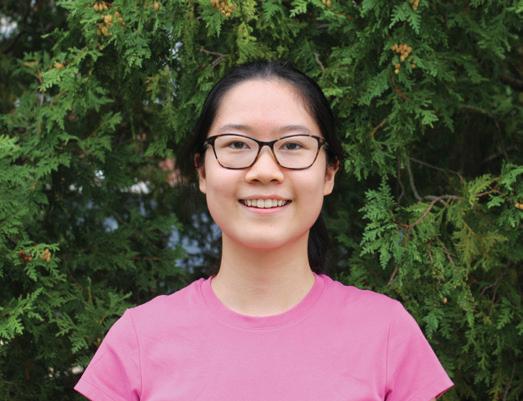
In the span of just a few hours on Sept. 27, three people threw canned tomato soup on Vincent van Gogh’s “Sun owers” at the London National Gallery. Previously, London police arrested two individuals who performed the same stunt in 2022. e incidents have something else in common — the soup-throwers were all members of Just Stop Oil, a climate activist group based in Britain whose demonstrations o en draw controversy for supposed vandalism.
As an artist myself, when I saw the images of soup drowning out the delicately painted sunflowers of one of Van Gogh’s most famous works, I was appalled and honestly, angry. However, the
painting was fine. Not only was it protected with a thick layer of glass, but the activists only threw the soup in the first place because they knew about the protection.
The frame was damaged, but even then, Phoebe Plummer, the activist who performed this demonstration in 2022, made a provoking point: “Are you more concerned about the protection of a painting, or the protection of our planet and people?”
The reaction we get out of these acts of vandalism is an effective reminder of how we should feel about global warming and the destruction of our natural planet. In fact, some argue that Van Gogh himself would have supported these acts as a radical who was ostracized in his art community at the time and an avid nature lover.
Regarding the shock value of feats like the “Sunflowers” incidents, many often preach that Just Stop Oil should be doing something better with its time, perhaps protesting at actual oil refineries rather than causing commotions at museums and disrespecting historical pieces of art.
But as revealed in journalist Sam Light’s 12 interviews with Just Stop Oil members, activists did, in fact, try to target Big Oil. However, from protesting at oil depots to blocking commercial trucks and fossil fuel infrastructure, nothing quite made a splash. en, they pulled o the “Sun owers” stunt, bringing a tidal wave of attention to the organization and cause. From there, the choice became clear on which avenue to pursue, even with the public backlash they knew would follow.
While research cannot definitively say whether attention-grabbing and disruptive shows of activism affect climate activism negatively or positively as a whole, University of Bristol psychology professor Colin Davis’ attention theory of change suggests that it is likely that all press is good press. While most people are aware of climate change, it is a topic that usually remains in the back of our minds. Sometimes, we need bizarre headliners to jolt it into the conversation again because it is arguably the most urgent issue we face today. History told its makers countless times in radical movements that their methods were too extreme and unnecessary, but only time will reveal the necessity of discomfort in the moment for the service of a better future.
In the October issue, on page 5, the caption “Signs of life” incorrectly mentions the National Art Honor Society as “National Art Society.”

We’ve all had the impulsive need to plug our headphones or earbuds in and tune out with relaxing, enjoyable music while we complete our dull and tedious homework. I’ve often found myself turning to musical comfort when trying to complete 30-pagelong world history notes or long wordy math problems. It just made doing the extremely boring work easier when I had something I could enjoy listening to. But one weekend, I conducted an experiment out of curiosity. A er spending a day listening to my favorite playlist while studying on Saturday, I forced
myself to keep my earbuds in a di erent room while working on Sunday. Shockingly, what took me four hours on Saturday had been reduced to nearly half the amount of time and e ort on Sunday. A er working with music through all of high school, I’ve realized that while it made my assignments less boring, it became a distraction while trying to make my work its best quality. I was focusing on the music rather than my assignment, and I wasn’t using the full scope of my creativity toward producing high-caliber work.
chology tried to test music’s e ect on creativity through three di erent experiments, having subjects either listen to background music with foreign lyrics, music with lyrics in the listener’s language or instrumental music with no lyrics. e study measured their
on Compound Remote
enced reduced levels of creativity and a greater inability to complete CRATs than when they had a quiet environment.
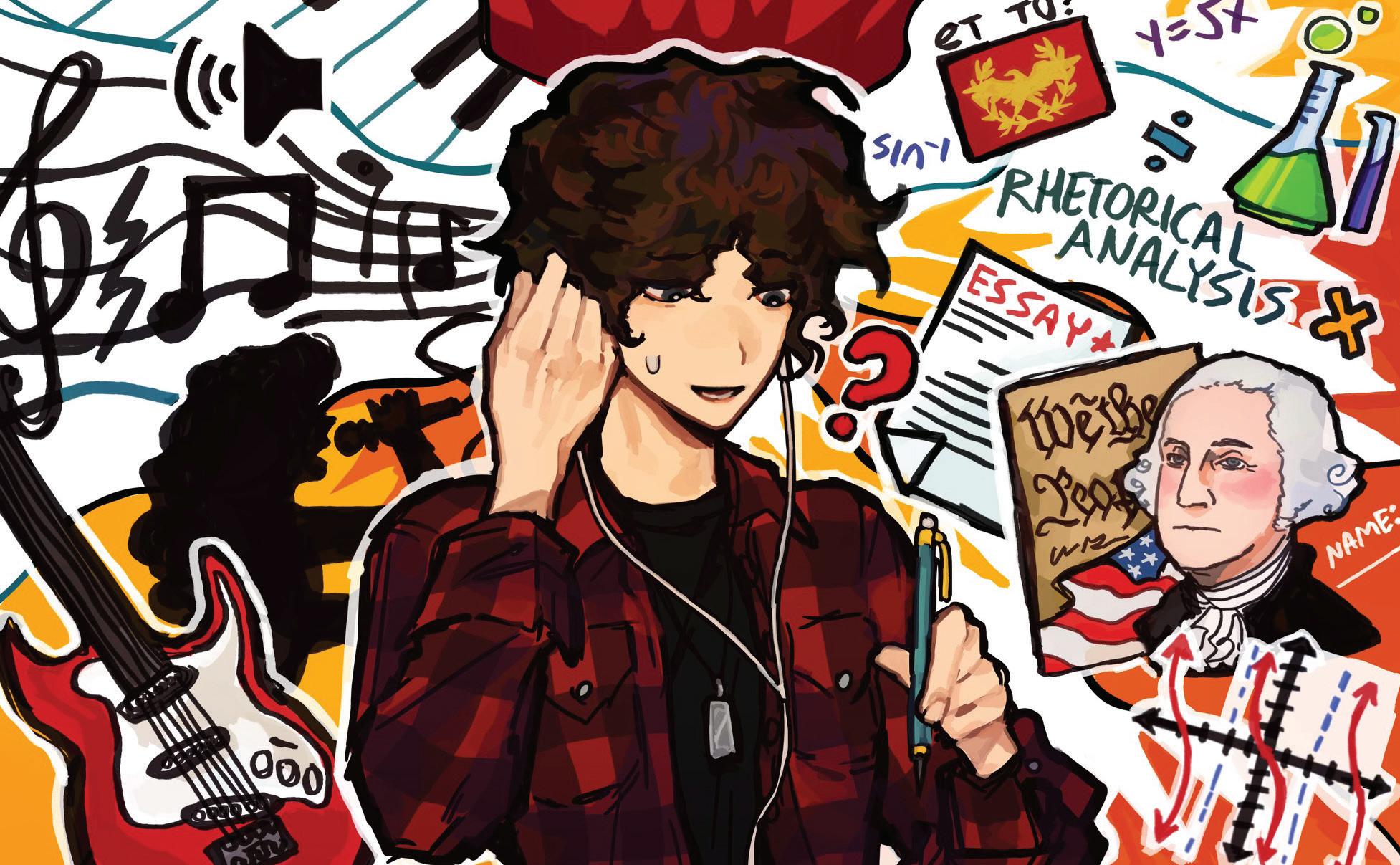
Associate Tasks (CRATs), a type of problem-solving task. No matter the genre of music, everyone with background music experi-
Even though music might motivate you to complete monotonous work, constantly blaring music through your ears is another distraction we’re convinced is good, just like constantly checking our phones or scrolling on social media. In the end, we’ll start to focus more on the lyrics or the beat of the song rather than the details or instructions of your assignments. Music isn’t just bad for assignments that require focus and creativity; listening to mu-
sic while studying will impact any kind of memorization or active recall needecd for a test. In a research study in Psychology of Music, two groups read the same article and attempted to recall information from it, but one group listened to music while the other group had no background noise. Compared to the group with no music, the music listeners had more trouble recalling speci c details from the reading and were more disturbed during the reading process.
Sure, we could use calm music while doing easy assignments and make that work less boring or daunting, but there isn’t truly any assignment in high school where you don’t have to think creatively or memorize information. We can’t justify listening to music as productive when all it’s doing is hindering our productivity for these assignments. So try taking your earbuds out next time you sit down to memorize de nitions or take notes — see how you can whittle down hours of work into minutes.



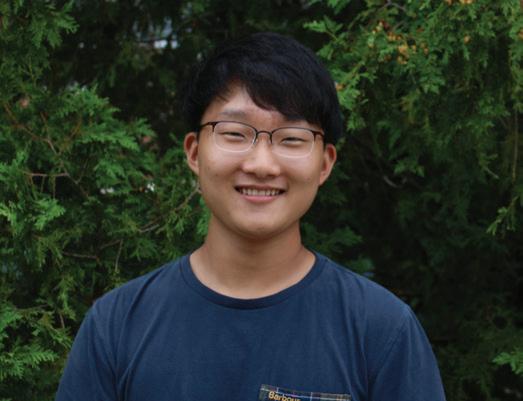
Howard Kim
Co-Editor-in-Chief
As Founding Father and second president of the United States John Adams once said, “A division of the republic … is to be dreaded as the greatest political evil.” ese words ring truer than ever in today’s political climate, especially given the tense atmosphere in the recent election season. e political aisle that could once be crossed with a handshake, a smile and a willingness to compromise now requires weeks of tense negotiations and political gamesmanship. For example, government shutdowns, which occurred for the rst time a mere 44 years ago, are now routine events in Washington. During the eight di erent administrations that have held the Oval O ce since then, there have been 10 federal government shutdowns and even more funding gaps. American politics have become polarized and stagnant, and a major reason for this is the two-party system.
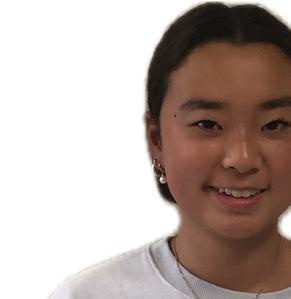
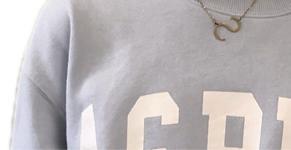

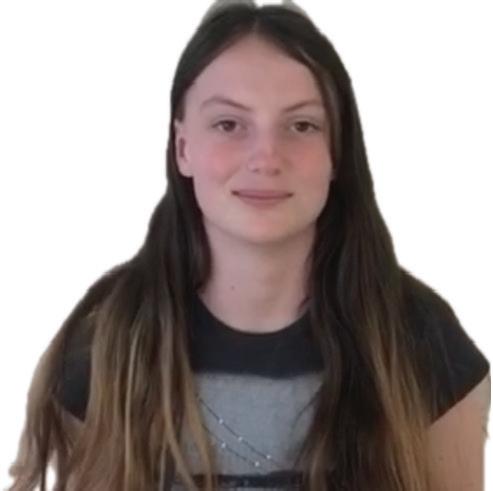

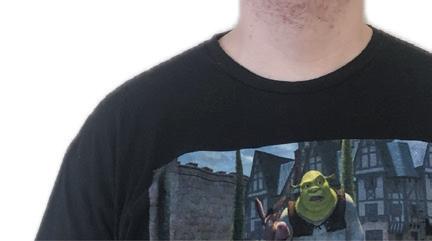
According to Emory University political science professors Dr. Alan Abramowitz and Dr. Steven Webster, “a growing number of Americans have been voting against the opposing party rather than for their own party.” Because politicians today know that they only have one legitimate competitor in each election, they xate more on ensuring their constituents don’t vote for their opponent rather than winning them over with their own platform. is ultimately leads to poorer representation of voters’ true concerns and more deeply entrenched party lines. Fortunately, there is a way to alleviate
ica’s western territories. Because neither the Whigs nor the Democrats officially represented this stance, Americans exercised their political voices by voting for a party that would, demonstrating that the ultimate power to shape our politics lies in the people’s hands.

the problem, and it is not a new idea by any stretch of the imagination: voting for a third party or independent candidate. Despite there being no notable third parties in the last few decades, they have played pivotal roles throughout much of American history. In fact, the Republican Party was once a third party, rising to political influence by standing against the spread of slavery in Amer-
Opponents of third parties often argue that voting for a third party is pointless since past candidates, such as the Green Party’s Jill Stein and the Libertarian Party’s Chase Oliver, haven’t gotten enough votes to be elected for decades. However, by voting for third parties, especially in tight elections where the dominant parties compete over every last vote, third-party voters can force candidates to add certain issues to their platforms, providing more inclusive representation, even if the third parties themselves don’t win. As Adams also once said, “We electors have an important constitutional power placed in our hands … let us neglect all party loyalty.” Our democracy — which is dependent on cooperation — has lost its humanity to party politics, and it’s up to us as voters to let politicians know by voting for a party that will truly represent us, even if it’s neither red nor blue.


Eshan Singh Co-Copy Editor
Republican Donald Trump won the 2024 presidential election by securing 295 electoral votes as of two days a er the election, beating Democrat Kamala Harris.
As of Nov. 7, Independents Robert F. Kennedy Jr. and Cornel West, Green Party candidate Jill Stein, Libertarian Party candidate Chase Oliver, and Party for Socialism and Liberation candidate Claudia De la Cruz earned a grand total of zero electoral votes.
Third-party and independent candidates are those that do not represent the Democratic or Republican Parties, the two major parties in the United States. Because these candidates have no real chance of winning the election, Americans should not vote for them, even if they prefer a third-party or independent candidate over the Democratic and Republican nominees. One reason why it’s so di cult for third-party and independent candidates to win elections is the lack of ranked-choice voting, which is a system where voters can rank candidates by prefer-
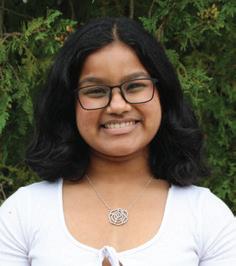

ence. Under the current voting system, voters can only express support for one candidate, so they usually vote for the major-party candidate because that candidate is more mainstream. According to the Federal Election Commission, in the 21st century aside from the 2024 election, the average national vote percentage that went to all third-party and independent candidates is only 2.58%, and the highest individual vote percentage was just 3.28%.
e Electoral College further hurts third-party and independent candidates’ ability to win elections. Usually, all of a state’s electoral votes go to the winner of the state, and since third-party

and independent candidates consistently receive fewer votes, they seldom get any electoral votes at all; in fact, the last time someone other than a Democrat or Republican won a state was in 1968. Even if a third-party or independent candidate were to win some states, it’d be practically impossible for them to earn enough electoral votes to win the presidency.
In this regard, voting for a third-party or independent candi-
date is essentially the same as not voting at all, which is why Americans should vote for either the Democratic or Republican nominee. If you don’t like either nominee, you should vote for whomever you dislike the least. Some people who vote for third-party and independent candidates believe that it is morally wrong to vote for a candidate that they think would be a poor president. However, voting for someone doesn’t necessarily mean you support them; it just means that you think they’re the best option, and because it is virtually impossible for third-party and independent candidates to win, you cannot consider them actual options. Voting for a third-party or independent candidate can hurt a major party candidate, a phenomenon called the spoiler e ect. In 2016, if everyone in Wisconsin, Pennsylvania and Michigan who voted for Green Party candidate Jill Stein instead voted for Democrat Hillary Clinton, the more
Rowan Chetty and August Zangrilli
Co-T/E Life Editor and Staff
On Sept. 27, the Conestoga field hockey team won its match against Garnet Valley 5-1. This game not only ended in a victory for the team, but was also marked a milestone for head coach Reagan Marscher: her 100th win.
Marscher began coaching the team five years ago. A 1995 Conestoga graduate herself, Marscher played on the field hockey team when she was a student. She believes field hockey in the Central League has changed since her time on the team.
“Back when I was a player, the other teams in the Central League dominated. It was highly competitive,” Marscher said. “A lot has changed since then, and we are now approaching our fifth consecutive Central League championship win.”
Over the years, Marscher developed her coaching philosophy to emphasize camaraderie and hard work.
“I would say two main pillars are one, a supportive network of teammates. We really encourage that as a group; whether it’s cheering for teammates or lifting them up during the game, that’s huge for us,” Marscher said. “The other is an extremely hardcore work ethic. We take practice really seriously. Whether it’s just some random practice or the day
before a big game, we always give one hundred percent or more.”
Senior co-captain Shae Wozniak has played under Marscher for four years. She appreciates Marscher’s dedication to training.
“She always stresses the importance of hard work. We take everything seriously, and I think that pays off with our wins,” Wozniak said. “She is just an inspiration to all of us.”
To help prepare for games, players pass around the book “Mind Gym” by Gary Mack and take a “Mindful Minute” before games to help them stay calm. According to Marscher, many teams play more aggressively against Conestoga due to its impressive record.
“We always have a target on our backs because everyone wants to beat ’Stoga,” Marscher said. “On the back of our shirts this year, it says ‘pressure is privilege.’ We’ve earned that pressure over years of supporting each other. We welcome that pressure because it only makes us stronger.”

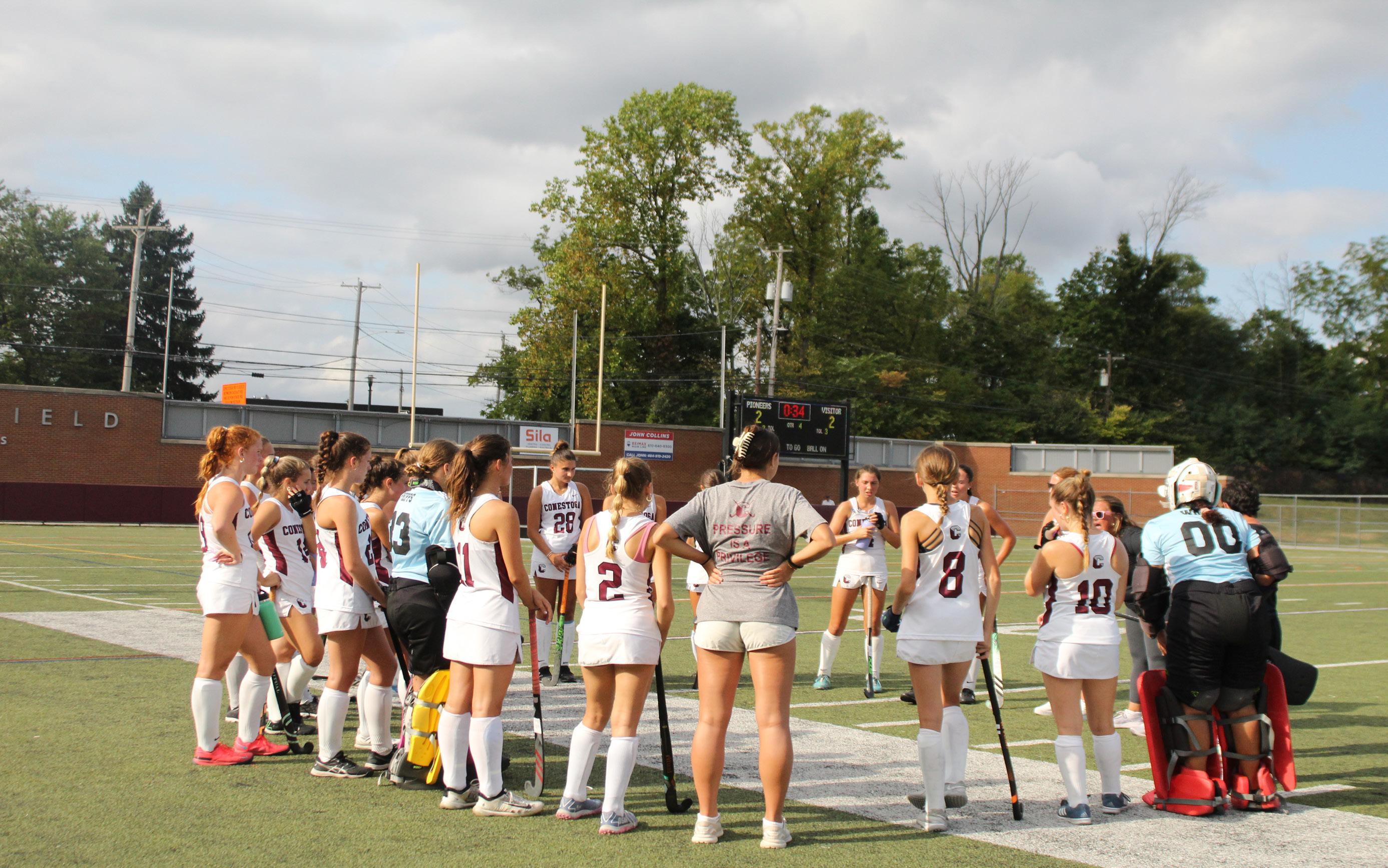
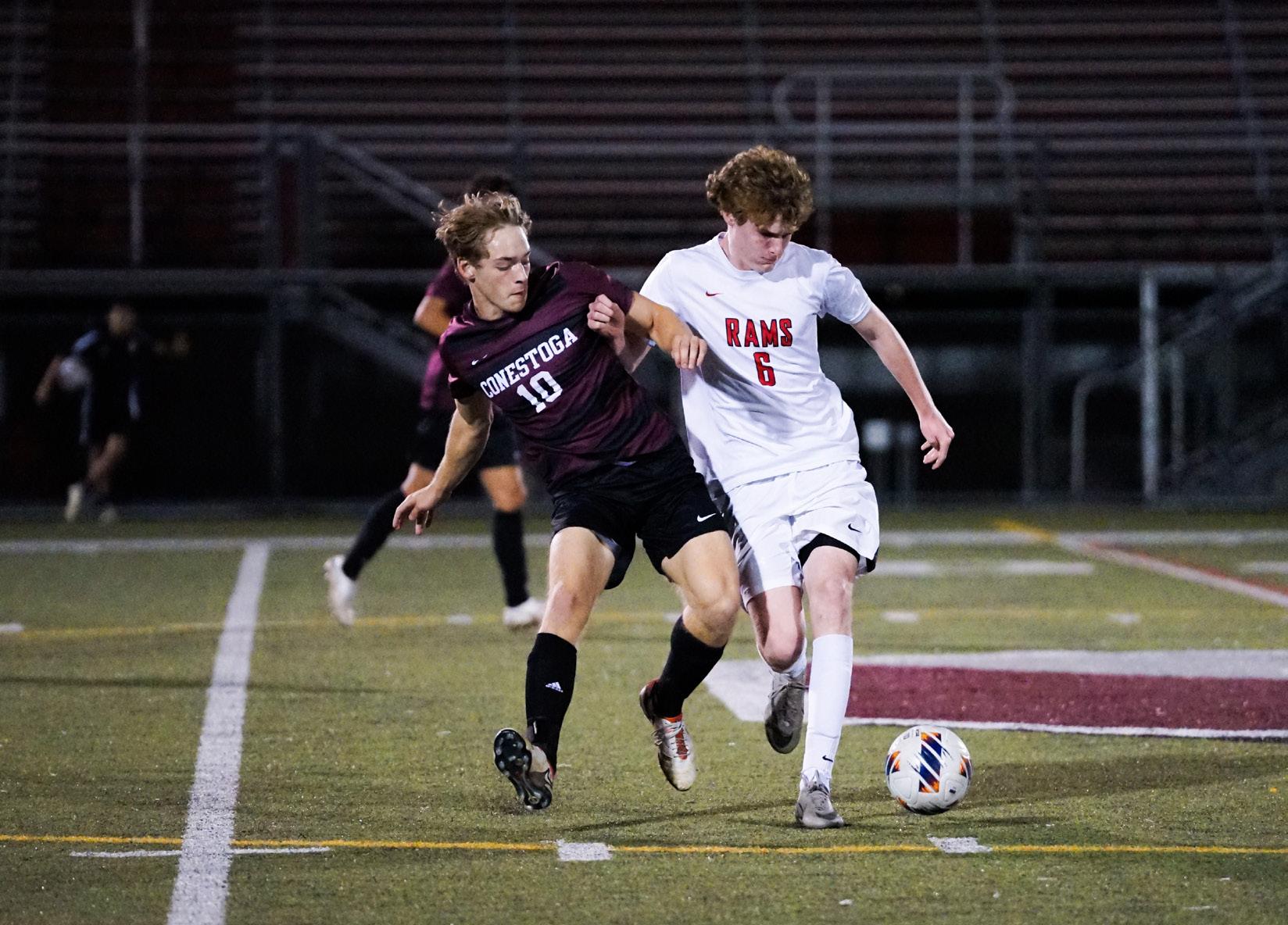
per competitive,” Breault said. “I think that since I’ve just been doing it for a really long time, once I got to a certain point, I was really good at it, and I just wanted to keep dancing.”
In April, junior Sadie Breault will board a plane to Dublin for the 2025 World Irish Dance Championships. While this may be a once-in-a-lifetime experience for some, Breault will step onto the world stage for the third time in her life, competing against girls from across the globe and following in her family’s footsteps.
“My grandfather was an Irish immigrant, so he inspired my mom to start dancing. My mom and her sisters danced at a school called Coyle. They didn’t dance for that long, and they weren’t su-
Breault began Irish dancing after her mom enrolled her at the McDade-Cara School of Irish Dance in Newtown Square when she was 3 years old. She started competing in tournaments when she was 6 years old and has since participated in the World Championships three times, the North American Irish Dance Championships six times and the Mid-Atlantic Oireachtas eight times.
“She has advanced to the top level, and she’s going to be competing at the world champion-
ship in Dublin. To qualify for that event, you’re pretty much in the top 1% of the dancers around the world,” said Annemarie Sheehan, Breault’s coach at the McDade-Cara School. “That’s going to draw people from every continent, and she’s going to be competing against the very best when she gets there.”
Sheehan has coached Breault for over 13 years. She is particularly impressed by Breault’s hard work and leadership abilities while helping to teach younger kids during classes.
“She’s always been mature. She was mature when she was young, but she’s very much grown into a leader,” Sheehan said. “She’s the person that the

Vaishnavi Sriadibhatla
According to the National Institutes of Health (NIH), around 90% of high school athletes experience sports-related injuries during the season or at some point during their high school athletic careers. The main variables that vary from injury to injury are the severity of the injury and the predicted recovery time. With injuries being so widespread among student athletes, they can affect an athletes’ mental health, further taking a toll on their performance. Katie Ryan, a 2010 ’Stoga alumna and mental health specialist who runs her own clinic has worked with athletes in the Main Line for several years, and believes that this is often the case due to a strong correlation between athletics and mental health.
teachers and the students all like to be around. She’s just a model student, a real pleasure to teach.”
As an advanced dancer, Breault attends two to three dance practices a week that are each two to three hours long. Her practices increase in intensity as she gets closer to competitions and performances. In addition to practices, Breault participates and volunteers in community service events with the McDade-Cara School, including visiting nursing homes and special education schools with her fellow dancers and performing in an annual St. Patrick’s Day parade.
“She’s a great example and a great ambassador for Irish danc-

“Athletes, especially if you’re a competitive athlete, have this natural tendency to put a lot of pressure on yourself. You want to be the best, and you want to keep pushing yourself to get better and better”, Ryan said.
“While pressure can be a good thing, it can motivate you to want to get better, to improveit can also become really stressful. It can kind of change in a way where it starts to impact self-esteem or it can cause dysfunction in other areas.”
Psychological symptoms that athletes face include depression, struggles with confidence and a loss of identity.
“When an athlete experiences an injury, especially an injury that takes them out of the sport for some time, it is a really emotional experience. If an athlete identifies with their sport, if it is a huge part of them, and it is taken away from them it leaves them with a feeling of ‘Who
ing,” Sheehan said. “We are really proud that she represents our school because there’s a lot of schools in the area. Philadelphia has a lot of Irish history and a lot of Irish dancing schools, so we’re really proud that Sadie is one of our dancers.”
Like many other Irish dance students, Breault anticipates that she will likely stop dancing toward the end of high school. Despite this, she believes that dancing has played a significant role in her life and helped shape her identity.
“I think that it’s a big part of my life. I don’t know who I would be without Irish dance. I feel like I’ve tried other sports, and I didn’t really like them as much,” Breault said. “Irish dance is like my thing, and I feel like it’s important to have your thing. It helps me to define who I am.”
am I? What am I supposed to do without playing my sport?’” Ryan said.
There are still ways for athletes to stay involved with their team and maintain their fitness.
While injured, athletes can support their teams from the sidelines and discuss strategies with them. They can also participate in basic drills to stay active and agile. To keep themselves occupied, they can take some time to develop their other interests beyond their sport.
Senior Jake Frischmann, a midfielder on the boys’ varsity soccer team, suffered several injuries throughout his high school career and had to sit out. He describes taking up other hobbies to keep himself engaged.
“I ended up having to be active in other ways. I ended up lifting a lot and doing calisthenics,” Frischmann said. “I see that with all my friends who get injured, especially if they’re
injured for a year or longer. They have to find other things, whether it’s golfing or lifting or whatever it is that they can do while they’re still being injured.”
Junior Jenna Khalil, a striker on the girls’ varsity soccer team, suffered a medial collateral ligament tear that required her to take a sixmonth hiatus from soccer. Jenna Khalil believes that an athlete’s career does not end at an injury, instead she sees an injury as a brief break. She encourages athletes to keep on persevering because they can discover other newfound passions, take some time to focus on themselves and continue to improve in other ways.
“Keep your head up and know it gets better. During this time, maybe encourage your other teammates,” Khalil said. “You can take this time to help improve yourself in other ways besides your (athletic abilities) by focusing on self-development.”




A er wearing No. 30 for four years, senior Cheyenne Bird closed out her high school volleyball career with the end of the 2024-25 season.
Bird started volleyball after quitting gymnastics and making the volleyball team as a freshman. She plays club volleyball for Synergy Volleyball Club and has played on its National 1s Team for the past three years. As a setter and a hitter, she leads the team in kills and aces. Bird comes in second in digs and third in blocks. During her sophomore year, she set a school record of 310 kills.
“It was the rst time in ’Stoga history that someone had accomplished that. e previous record was 231,” Bird said.
“It was de nitely a con dence booster because it showed me that all of my hard work was paying o .” Bird has continued to work on her skills throughout her high school career. Over the last three years, she battled through a broken leg while becoming a leading player on the team. is year, she is a co-captain and has maintained commitment through training
“Progress takes practice, and that is de nitely one of the hardest things to learn as an athlete, especially if you’re trying to learn a skill that you can’t get on your rst try. But in terms of improving my skill,
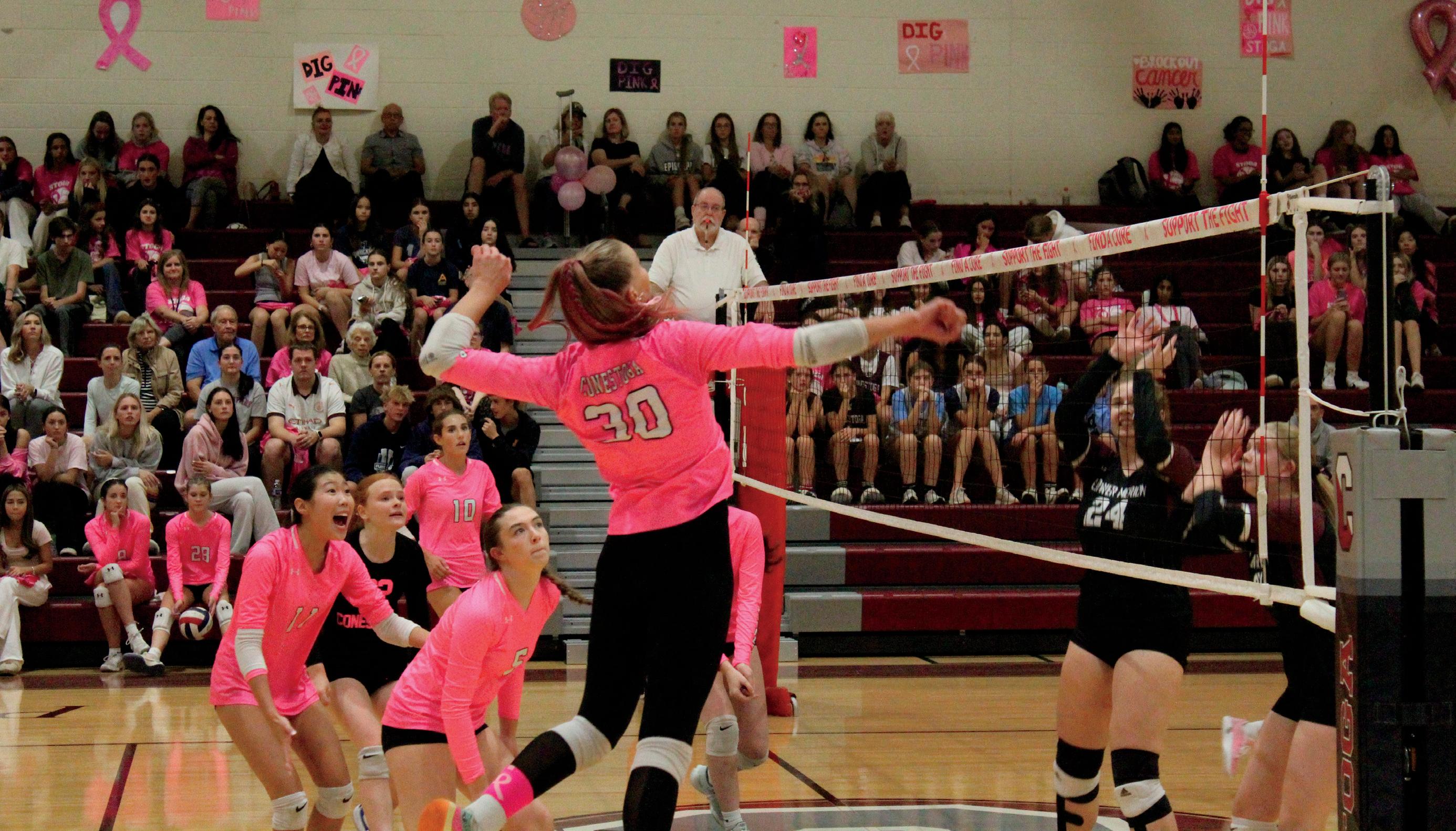
I would say (it takes) lots of practice, discipline and being open and able to being coached,” Bird said. Her teammates appreciate her work ethic and overall impact on the team. One teamate
that shares these sentiments is varsity player and sophomore Clare O’Donnell.
“Her competitive nature inspires the team and motivates us to play as the best versions of ourselves. Her dedication speaks for itself and helps us all want to improve,” O’Donnell said. Bird is committed to play Division II volleyball at Coker University next fall. She is continuing to play due to her love and passion for the sport. Bird is eager to push her ability and play with new people in the future. “I’m looking forward to being a part of building a high-level program at Coker University with my new coach and amazing new teammates,”
said. “I’m (also) looking forward to getting new experiences and competing at a higher level than what I’m used to as well as building my volleyball knowledge and building my skill.”


We don’t just teaCh the tests. We take them too!
FLEXIBLE Online or in-person Group Discounts 7 days a week HELPING CONESTOGA WITH: Digital SAT/ACT AP Exams Study Habits Academics Application essays.
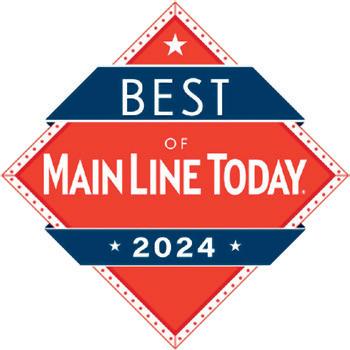





Last year, 11 seniors on the girls’ ice hockey team graduated. To adjust, the team expanded its JV program to include more games and has been working with many of the younger players to fill the gaps. The team currently has 30 members with 10 varsity, 10 swing and 10 JV players.
After six practices and four JV games this fall, the girls’ ice hockey coaches can already see improvements in many of their newer players and have optimistic views for the upcoming season.
“We de nitely lost a lot of our talented players last year, but a lot of the new girls are really stepping it up and improving a lot, especially with the JV games,” senior and captain Lila Valdesalice said.
e girls’ ice hockey team expanded its program to now have 15 JV games this fall season. is opportunity gives many of the newer and less experienced players a chance to play with opponents at the same level and learn the rules of the game in a less stressful environment.
“The number of JV games is a lot more, and you just play them for fun. I feel like that’s good for all the new people because they can learn the rules and not be punished for it,” freshman player Flora Valdesalice said.
The team practices most Mondays and every Tuesday. During practices, the team splits into groups based on skill and experience, so the coaches can help certain players with specific things they need to work on. This gives many girls the oppor-
tunity to get one-on-one help and advice from coaches.
“They are all so nice, and they always help me. The coaches are the best people in the world, and it’s just the best environment ever. I’m always looking forward to seeing them,” sophomore player Leticia Amorim said. The coaches and captains have already seen improvements in many of the players, showing that their approach and the expansion in playing time for junior varsity has been proven beneficial.
“Our players learn and develop in amazing ways. They’re great kids, and it’s just fun to be around them,” head coach Tony Parisi said. “We’re grateful every time we get on the ice with them. We have kids who already this year have improved dramatically.”
Abby Chong Co-Sports
Editor
Conestoga teacher Roheem Roten began his climbing journey seven years ago.
Though he was always athletic — running track in high school and playing soccer during college — it was not until after graduation that Roten found his true passion: rock climbing.
Three and a half years ago, Roten began coaching rock climbing at the Gravity Vaults climbing gym in Radnor. He teaches twice a week and focuses on reinforcing climbing fundamentals and fostering a welcoming community among his students.
“I try to instill positive affirmations. That’s the thing about climbing versus most other sports. Climbing is probably the most supportive sport I’ve ever been a part of. Even people you’re competing against are cheering you on and want you to be successful,” Roten said. Despite his love for rock climbing, Roten has a fear of heights. He does not let this deter him, but rather sees it as a challenge to overcome. By checking his rope, harness and other equipment before every climb, Roten helps calm his nerves and gives himself confidence to face his fear.
“I’m still afraid of heights. I have a certain threshold, a certain height, where my body just reacts. It’s just like, ‘Okay, you’re doing something very danger-
ous,’” Roten said. “It’s physical, but it’s more mental than anything. (You) just have to tell yourself, ‘You’re going to be ne; you’re going to be okay.’” Roten believes that climbing is a sport that requires not only physical strength, but also mental resilience.
“Climbing is a very patient sport, but it’s also a dangerous sport,” Roten said. “If you practice your patience and make sure you’re being safe, you can do a sport for as long as you want.”
One of Roten’s most memorable climbing experiences was last season, when he successfully completed a climb called “Twisted Sister.”
“I remember having this euphoric moment of accomplishment,” Roten said. “I was like, ‘Yes, I did it!’ It was probably one of the best feelings that I’ve had in a long time as an athlete. It just felt amazing.”
Roten encourages everyone to begin rock climbing, emphasizing that age does not matter when it comes to the sport. He affirms that all you need to be successful is patience and persistence.
“Go in there with no expectations. It is hard. It’s not easy, but it’s more about the journey than the destination,” Roten said. “Climbing is one of those sports that a lot of people say, ‘Oh, I wish I would have done it (when I was) younger. I’d be better at it now,’ but it’s really one of those sports where the longer you do it, the better you can get.”
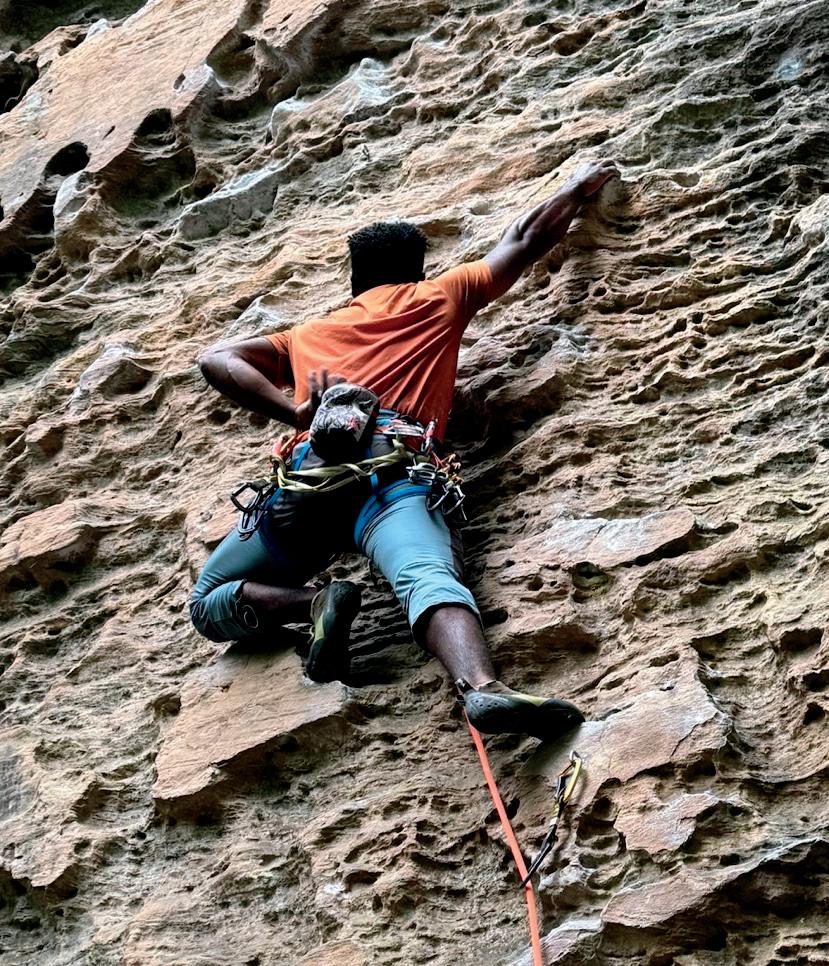
Student athletes cope with sports injuries
Page 10
Junior excels, competes in Irish dance
Page 10
Reaching new heights: Conestoga teacher rock climbs
Page 11
Girls ice hockey strengthens junior varsity program
Page 11

Dating back to the Vedic period around 1000 BCE, the earliest Indian religious texts describe creation in terms of dance. Today in the T/E community, students carry on this act of storytelling by participating in traditional Indian dance. ere are four main schools of Indian dance: Bharatanatyam, Kathak, Odissi and Kathakali. All di er in style, steps and theme. Senior Anika Maganti has been dancing Bharatanatyam for 11 years. With origins in the Natyashastra — a Sanskrit trea-
tise on the arts attributed to Indian music theorist Bharata — this dance form o en revolves around the gods of Hinduism and how their stories have been created.
“It (Bharatanatyam) is a classical dance. It’s very rich with Indian movements. It’s sti — it focuses more on exact things that you do, rather than the ow,” Maganti said. “A lot (of) other forms of dance are more free with your body and your facial expressions, but in Bharatanatyam, you have to hit every single step.”
Maganti practices at the ree Aksha Dance Company. She believes that dancing has enhanced her time manage-
ment, as the team practices on ursdays and Sundays and participates in a show about once a month. Maganti enjoys being a part of a close-knit dance community.
“ e girls I dance with, we’ve been dancing together since we were in elementary school. It’s really a special friendship because we’re alike in the sense that we’re so far away from our culture that we can all fall under this experience,” Maganti said.
Kathak is a dance form originating from professional Brahman storytellers, or Kathakars, of northern India and is characterized by its precise footwork and facial expressions. Junior
Vibudha Tandon rst began dancing Kathak as a child living in Singapore and now practices and studies the dance at Nupoor Dance School.
“Within Kathak, there is the word ‘katha’ which means ‘to tell a story,’” Tandon said. “Of course, there’s technical aspects of Kathak, but there’s also a storytelling aspect, which makes Kathak very distinct from other dance forms in India as well.”
Similar to Maganti, Tandon recognizes not only the broader cultural importance of preserving Indian traditional dance, but its impact on her life personally.
“I’ve been doing (Kathak) since I was 5, so it is very in-
tegral for me. I moved around a lot. I was born in Michigan, and then I moved to Singapore, and I came here,” Tandon said. “But the one constant in my life has always been dance. It’s always kept me grounded and it’s always in me.”

Shrija Krishnan Business Manager
Senior and girls rugby
co-captain Sabrina Look plays in the forward line. As the first line of defense, forwards are typically the bigger and stronger players responsible for mauling, scrummaging and tackling. While Look believes forwards are critical for the team’s defense, she admits to having lied about the position she plays in the past.
“When people would ask me what position I’d play in rugby, sometimes I would lie and tell them I was a back because backs are the more feminine girls. They are the very thin, very fast (girls) and the people who mostly avoid contact,” Look said. “I didn’t want people to assume I was more masculine than I was because of the fact that I actually enjoyed that contact.”
Look explains that girls are reluctant to try the sport when they are older because they are not exposed to rugby from a young age. She believes stereotypes about femininity in sports result in a lack of exposure to rugby during developmental years.
“When people think of enrolling their daughters in sports, they think of cheerleading, they think of dance, they think of soccer even,” Look said. “But no one thinks ‘I’m gonna put my daughter in rugby.’ People think about their sons, ‘Hey, I’m gonna put my son in football.’ But for some reason, there’s almost a stigma about putting your daughters, your girls, into these contact sports.”
Despite difficulties surrounding stereotypes, senior and co-captain Paulina Yang believes that rugby is a unique sport that allows girls from
different backgrounds to join a team that fosters acceptance.
“What I really like about rugby is how different it is from other sports. It’s not similar to soccer or softball.
said. “Rugby is a hard game to learn and an even harder game to master. I sucked at rugby for my rst two years of playing it, and it only came to my junior year where I got better.”
I think it’s so cool how there’s just so many different elements that you can’t find from other sports,” Yang said. “No game is exactly the same, and you’re always doing fun things. In rugby, I think what’s really cool is that the team is really nice. I think we have one of the most welcoming teams.”
Yang explains that, unlike other sports teams, the rugby team struggles with recruiting freshmen to replace experienced players that graduate because girls lack exposure to the sport. According to Yang, recruiting challenges force the team to function as one cohesive unit despite disparities in experience levels.
“For the new players, there’s a really big learning curve,” Yang
Although the team has struggled with recruiting in the past, Look believes that the U.S. women’s rugby team’s bronze medal win at the 2024 Summer Olympics has led to more interest in the sport. She notes that the number of rugby teams ’Stoga competes against has doubled and hopes the momentum will continue as more teams start to emerge across the state.
“Before I leave ’Stoga, I want there to be 30 people on that field practicing,” Look said. “If I can get that, I will cry tears of joy. It’s all I can do to host team bonding events, design and print out posters, and spread awareness if it’s towards that goal of wanting to have a great community.”
